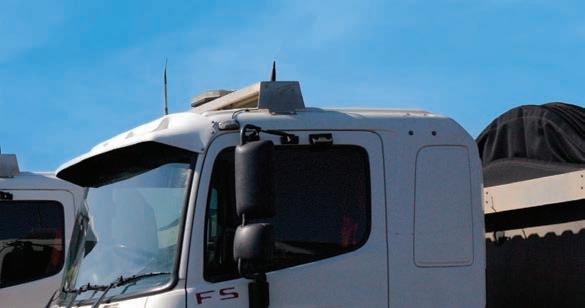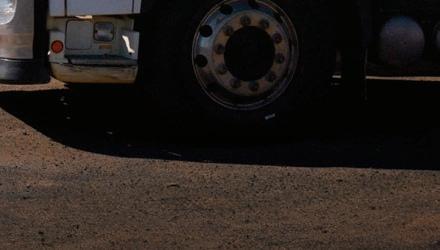


















0-100km/h in just 4.9 seconds. 180km of pure electric range. For more information email fleet@gwmanz.com





















0-100km/h in just 4.9 seconds. 180km of pure electric range. For more information email fleet@gwmanz.com

Datascape is a modern, cloud-based software suite designed specifically for local councils to streamline their operations, boost efficiency, and enhance service delivery — all while reducing complexity and administrative burden for council teams.
With a suite of enterprise resource planning (ERP) modules and digital enablement tools that can be used together seamlessly or individually, Datascape adapts to the unique needs of your council.
Datacom developed Datascape to integrate effortlessly with your council’s digital ecosystem – and it is has a proven track record with 80+ councils across Australia and New Zealand.

Purpose-built for local government in Australia and New Zealand.

Integrated ERP modules and standalone digital tools with robust reporting.

Open, API-rich software for seamless integration into your council’s existing digital ecosystem.
Scan to find out more


datacom.com/datascape



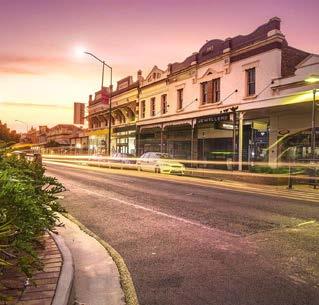
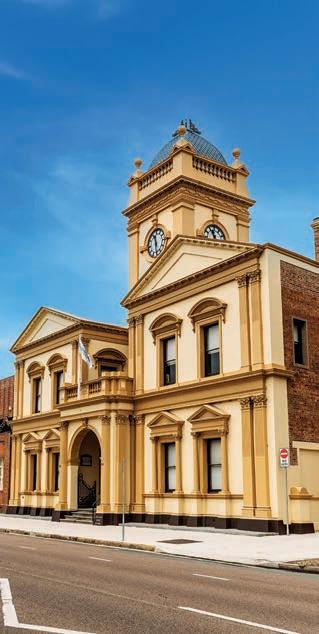





























































































































































































Byline
Published by
Chief Executive O cer
John Murphy
Chief Operating O cer
Christine Clancy
Publisher Sarah Baker
Managing Editor Laura Pearsall
Assistant Editor Kody Cook
Design
Danielle Harris
Head of Design
Blake Storey
Business Development Manager
Ryan Sheehan
Client Success Manager
Louisa Stocks
Head O ce
Prime Creative Media
379 Docklands Drive
Docklands Victoria 3008
P: +61 3 9690 8766
enquiries@primecreative.com.au councilmagazine.com.au
Subscriptions
P: +61 3 9690 8766
subscriptions@primecreative.com.au
Council is available by subscription from the publisher. The rights of refusal are reserved by the publisher.
Cover image
Ipswich City Council
Welcome to the Autumn 2025 edition of Council, packed with insights and innovations shaping the future of local government. Many of you will be in the thick of recovery from ex-Tropical Cyclone Alfred right now, and our thoughts are with our local government colleagues navigating the fallout of another natural disaster.
Many of you will also be thinking about the federal election, and the impacts this campaign will have on the local government sector. In this issue we’re pleased to share insights from ALGA President Matt Burnett, and the association’s campaign for federal representatives to Put Our Communities First. ALGA has outlined five key funding priorities for the elected government, which are detailed in this issue.
This issue reflects the dynamic landscape our councils are navigating, with a focus on vital areas that impact communities across Australia.
We delve into the robust world of civil construction, exploring the latest advancements in local government infrastructure development, and the challenges of delivering essential projects in a sustainable and efficient manner. From groundbreaking technologies to best-practice project management, we’re showcasing the initiatives driving progress in our cities and regions.
Sustainability remains a key focus around Australia, and in this issue, Ipswich City Council showcases some of the industry-leading work they are
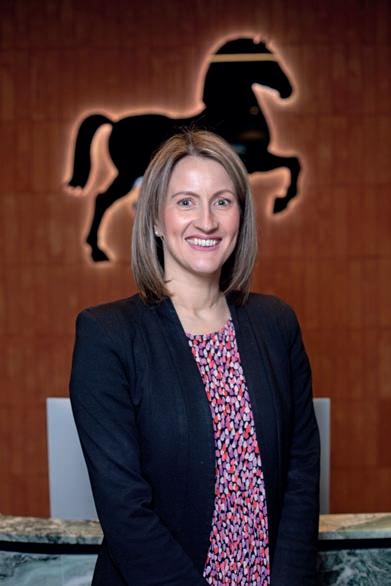
efficient, accessible, and sustainable transport networks. From smart city initiatives to active transport solutions, we explore how councils are shaping the way we move.
We hope this issue provides valuable insights and inspiration as you continue to build thriving and resilient communities. As always, we welcome your feedback and encourage you to share your own stories and experiences.
Enjoy the read!
Laura Pearsall Editor, Council
If you have a story idea, tip or feedback regarding Council, I’d love to hear it. Drop me a line at laura.pearsall@primecreative.com.au and don’t forget to follow us on social media – find us on LinkedIn, X or Facebook.
Council acknowledges Aboriginal Traditional Owners of Country throughout Australia and pays respect to their cultures and Elders past and present.

SUSTAINABLE & RENEWABLE MASS TIMBER BUILDING SUPPLIES


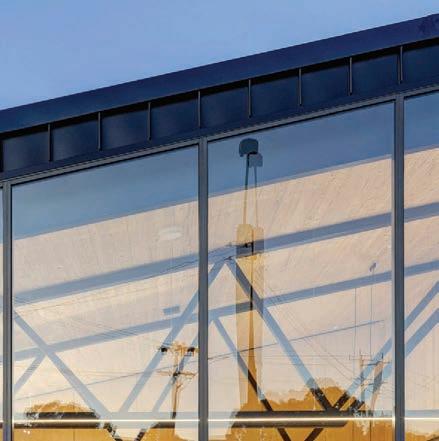
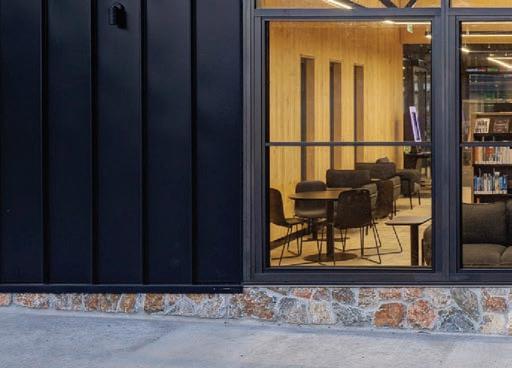
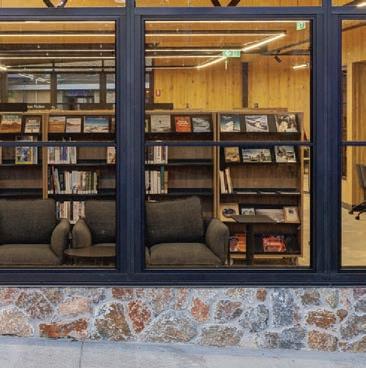

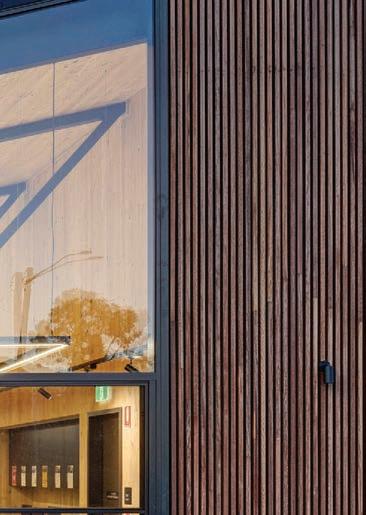

By Mayor Matt Burnett, President of the Australian Local Government Association
Australia’s 537 councils are calling for long-term sustainable funding to build better communities ahead of the federal election.
We are asking the next Australian Government to Put
Our Communities First and have outlined five key funding priorities as a significant uplift to all councils’ budgets:
•$1.1 billion per year for enabling infrastructure to unlock housing supply
•$500 million per year for community infrastructure
•$600 million per year for safer local roads
•$900 million per year for increased local government emergency management capability and capacity
•$400 million per year for climate adaptation
We want these new funding programs
– totalling $3.5 billion – to be distributed across all councils, on a formula-basis, similar to Financial Assistance Grants and Roads to Recovery funding, which has been successfully delivered for many years.
However, our success relies on the collective strength and engagement of your councils. I urge you to proactively engage with your federal MPs and local candidates to highlight the urgent need for long-term sustainable funding to better support your communities.
This will empower us to deliver local place-based solutions to the challenges
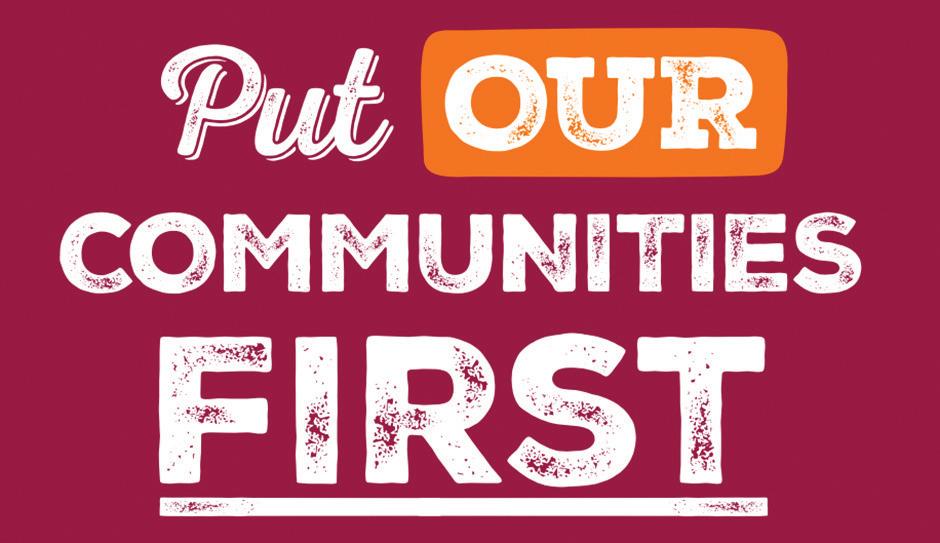
our nation is facing in affordable housing, road safety, natural disasters and climate change.
Importantly, it will also ensure every community across Australia benefits, including smaller, regionalbased councils that often miss out on competitive federal funding programs.
For too long, we’ve been stuck in a challenging grant round cycle, and we need to be better supported to deliver local solutions to national priorities.
I’ve already visited Canberra several times this year to brief Federal Ministers, Shadow Ministers and

crossbenchers on the importance of our proposed funding reforms. And it’s great to see they’re engaged and listening to our concerns.
But we also need your on-the-ground support to ensure that increasing funding for local government gets the proper attention and debate it deserves.
Last month, a Federal Parliamentary inquiry into local government sustainability – which received more than 280 submissions, including from councils – confirmed the need for better long-term funding.
The interim report showed councils have reached breaking point, after many years of delivering more local services and infrastructure but with less funding. It’s clear our current funding model is broken and needs to be fixed. That’s why we need your support this federal election to deliver fair funding for local government and put our communities first.
Having a strong, sustainable and vibrant local government sector is critical not just for our communities, but for the health, productivity and future of our nation.
For more information, visit putourcommunitiesfirst.com.au





The Victorian Local Governance Association has shared the results of its first ever VLGA Victorian Councillor Census, which highlighted the factors leading people to seek election, but also step away from re-election.
The VLGA Victorian Councillor Census has provided invaluable insights into the overall experience of a councillor across the duration of their four-year term. This is the first time any kind of Census has been conducted across the Victorian Local Government sector in more than a decade.
The VLGA Victorian Councillor Census looked to address the opportunities and barriers for councillors, their motivations for standing, any factors influencing their decision to stand or not stand for re-election, and identified areas where councillors required additional support.
VLGA CEO, Kathryn Arndt, said this groundbreaking work would help inform, influence and lead important conversations across the local government sector.
“Up until now we haven’t had any tangible data to support what we
were hearing anecdotally from elected representatives.
“The Census addresses a significant information gap and provides some great insights into how the sector can respond and be better placed to support and empower councillors to be successful in their roles in the future.
“This report will influence and lead conversations. The Census addresses an information gap when it comes to understanding how our democratically elected community representatives are supported to fulfill their duties, along with balancing their personal motivations and challenges.”
The VLGA will use this data to better support councillors in their role and improve good governance in the local government sector. It is also intended that the report be used by government to inform funding, policy and related sector discussions to enhance the outcomes councillors deliver.
The VLGA Victorian Councillor Census was conducted in collaboration with QDOS Research, who were responsible for collecting the data and ensuring the complete anonymity of respondents.
More than 300 councillors across Victoria responded to the VLGA Victorian Councillor Census with an average age of 57 years. This signifies a response rate of more than 50 per cent.
One of the most significant findings of the VLGA Victorian Councillor Census was identifying the challenges and barriers currently preventing women and men from re-standing as councillors.
Key findings included:
• The primary motivators to become a councillor were community service and a desire to enact change
• 47 per cent of respondents had served as a councillor for between three and four years

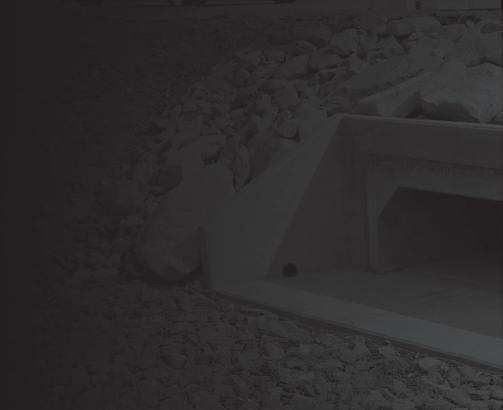
Our culverts are designed to meet the demands of council projects.
From bridges, stormwater drainage, floodways to underground utilities, our durable and cost-effective solutions ensure long-term performance you can trust.
LARGE STOCKS
FAST LEAD TIMES
EXPERT ADVICE
CUSTOM SOLUTIONS



AUSTRALIAN STANDARD COMPLIANT (AS1597)
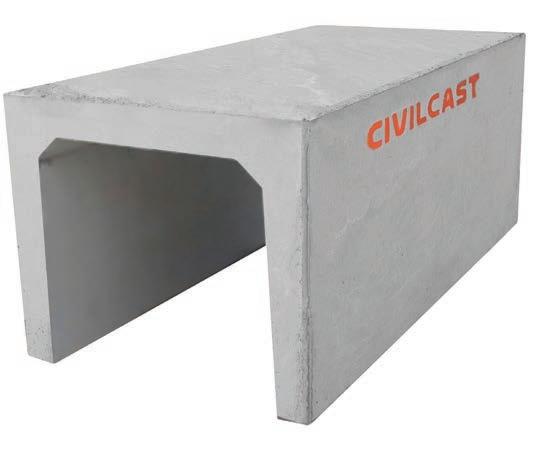

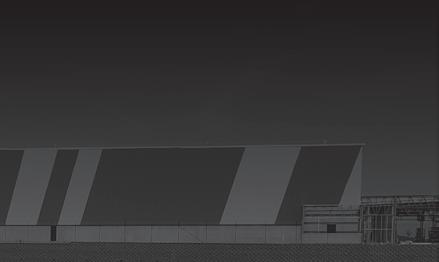

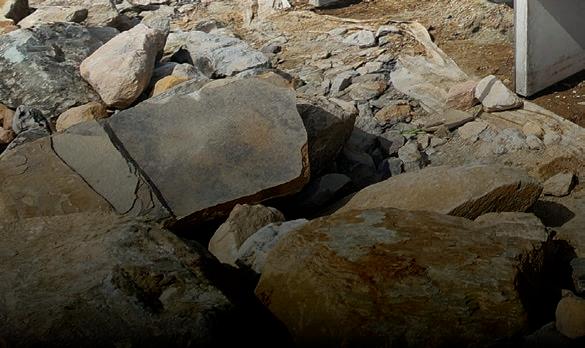

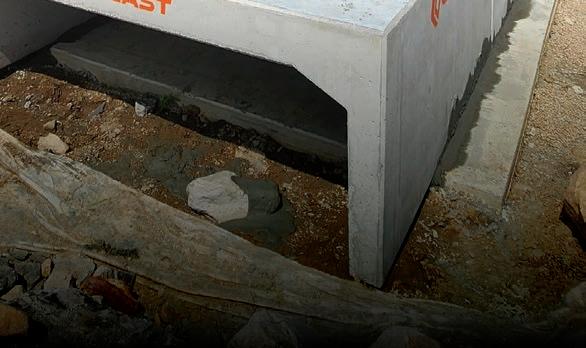


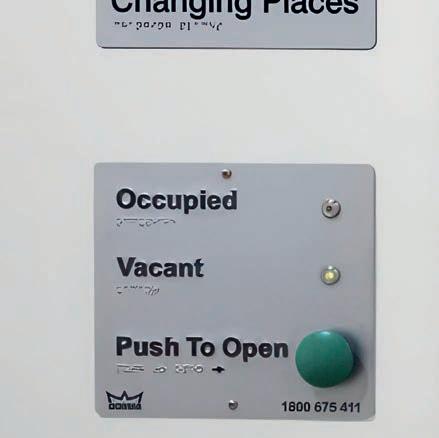

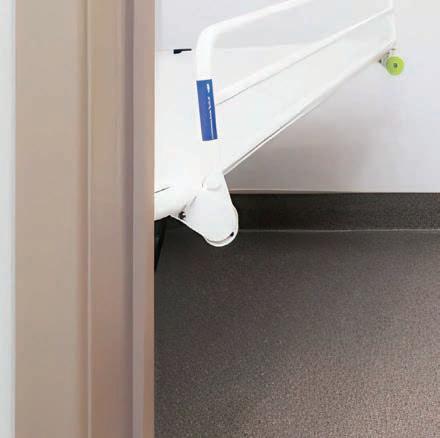

Enabling dignity and participation in community life
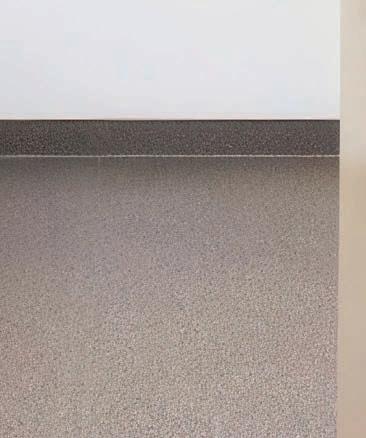
Architecture & Access helps councils create accessible facilities for people with high physical support needs

Contact us today to start your project

• The average weekly hours spent on council related activities was 29.2 hours
• A large percentage did not have a clear understanding of the strategic nature of the role initially
•Remuneration was not seen as commensurate to the time demands of the job
•A significant number of councillors did not expect the level of hostility they encountered, especially from other councillors
•41 per cent of women and 26 per cent of men regularly experienced threatening or intimidating behaviour from another councillor
•Bullying and harassment were identified as key factors for councillors, particularly women councillors, not standing for re-election
• 69 per cent agree that councillors should be entitled to claim childcare costs as part of performing council duties
•73 per cent would recommend the role of councillor to others
•More than 80 per cent of respondents stated they had experienced threatening or intimidating behaviour in their role as a councillor Ms Arndt said the VLGA planned to conduct the VLGA Victorian Councillor Census annually to capture and track councillor demographics, attitudes
and key challenges for local council governance over time.
She said the data had also helped inform the VLGA’s program of work including:
•The expansion of the Local Women Leading Change program to empower more women to nominate for council in 2028
•The development of an EAP Register to ensure councillors are aware of the health and wellbeing supports available to them and how to access them
• The development of a four-year Councillor Professional Development Program that directly aligns with the mandatory Victorian Government guidelines
• The expansion of the VLGA’s community leadership programs to encourage informed candidates in 2028 that represent the diversity of their community
• The formalisation of the VLGA’s advice network to provide councillors with expert governance and leadership advice
“The Census is a critical tool that has already directly informed the VLGA’s sector advocacy and our program of work moving forward,” said Ms Arndt. “It will also be used by government to inform policy and related sector
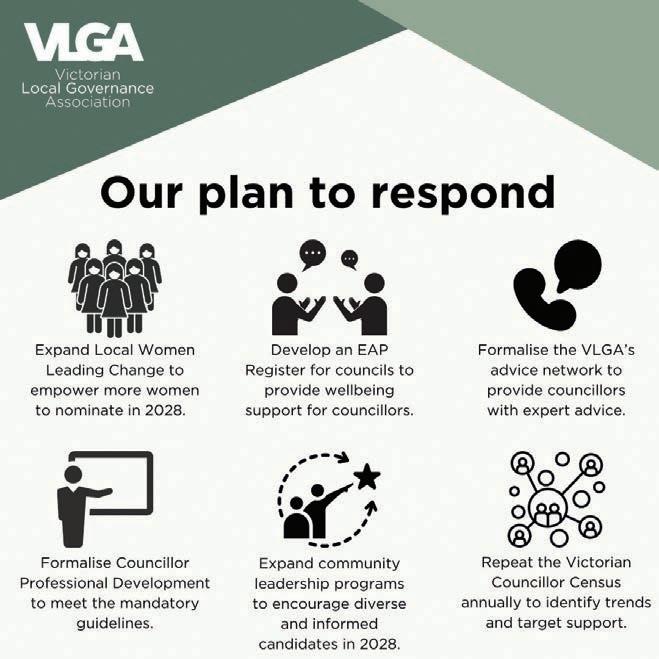
discussions in order to enhance the outcomes councillors deliver for the communities they represent.”
The first-ever VLGA Victorian Councillor Census elicited valuable data and a unique insight into the issues and challenges faced by councillors in their roles. It also highlighted the impact these challenges have on good governance in elected representation.
Armed with this information the VLGA is better placed to inform, influence and lead conversations across the government sector. It will use the commentary of councillors to better support their role and expand the efficiencies and effectiveness of the local government sector.
Going forward, the VLGA is committed to collecting this data annually to provide an accurate pulse check on the challenges elected representatives are facing; and to help identify what additional support or professional development is needed to ensure councils are operating proficiently and effectively.
It will also allow the VLGA and the Victorian Government to identify trends in the data provided and ensure that support programs are targeted appropriately, and issues are addressed and responded to proactively.
As a first step response to the findings of the VLGA Victorian Councillor Census, the VLGA recently launched its Councillor Professional Development Program, which not only aligns with the new mandatory training requirements set out in the Local Government (Governance and Integrity) Regulations 2020, but has also been informed by the findings of the VLGA Victorian Councillor Census.
The Councillor Professional Development Program is designed to inspire and support councils and councillors in good governance and set them up for success.
While the VLGA is Victorian based it does offer online training modules as part of its bespoke Councillor Professional Development offer. These are available to councils across Australia.
For more information about the VLGA’s Councillor Professional Development Program or to download the Victorian Councillor Census Report, visit vlga.org.au
Taking a council-focused approach to AI has enormous benefits. Image: Sasint/stock.adobe.com

As more local governments incorporate AI in their operations, the positive outcomes for public services are becoming impossible to ignore.
Agrowing number of councils around Australia are exploring how to implement AI in their organisations and use it to achieve the best outcomes for their residents and communities.
International AI expert and CEO of AI in Business, Katie King, recently undertook a tour of Australia and New Zealand, meeting with council representatives across both countries to share insights and outline her ten-step program for successful AI development and implementation in local government.
Katie explained that there are numerous promising AI technologies being adopted by local government organisations, spanning areas like efficiency in service delivery and decision-making, but there are some implementation challenges that need to be addressed first.
“Local governments are finding themselves facing several common
challenges when implementing AI technologies,” Katie said.
“One major challenge is the availability and quality of data, as councils often deal with fragmented and incomplete data from legacy systems and siloed departments.
“Cost is another significant challenge, with budget constraints making it difficult to balance innovation with the implementation of costly AI solutions.
“To address these challenges, local governments can start small, form partnerships, seek grants and consider cloud-based solutions to facilitate the transition and help manage costs.”
“AI has the potential to revolutionise local government.”
Katie said there is a mistaken perception by some that AI is going to come in and wipe away everybody’s jobs.
“It means all of us – if we can change our mindsets – can start to use some of these new tools and services to give us insights, to reduce the time spent on tasks, and to automate some of those routine mundane tasks that all of us have been doing for many years.
“I know what many council leaders are thinking – how do I ensure I get a return on investment from all of this?”
Councils are having to grapple with balancing innovation expenditure with measurable outcomes and savings.
“The starting point really needs to be strategic; ‘what are we trying to achieve? What are some of the problem areas? What are some opportunities?’ Rather than just jumping on the bandwagon and trying to use all these new tools.
“So how do you become a council that is an employer of choice? How do you demonstrate to your people and your potential staff that you’re
a progressive council and that they’re going to learn, and they’re going to be working in an environment that’s safe and exciting and challenging?”
THE TEN KEY STEPS TO AI SUCCESS
There are ten key points that make up the core of Katie’s ‘AI adoption playbook’, ranging from defining objectives and scope, through to testing, refining and developing use cases.
Step 1 – Mindset
Step one for councils is bringing teams together and ensuring they have the right mindset for change.
“What we all need to understand is that this isn’t going away, that these AI tools and platforms are revolutionising the way we offer our services and the way we run our councils, and we need to embrace that.”
Step 2 – C-suite support
Councils need the support of their leadership team before embarking on AI projects. Ask: Do we have the buy-in from the board, or the management team? Do we have their support in the adoption of these technologies? If not, this is an area that needs to be addressed urgently.
Step 3 – Business case
Developing a business case is critical.
“Many of the councils I’ve been working with have talked about how important it is to show that return on investment, to be strategic, not to just dive in and do something really tactically.”
Step 4 - Experiment
Experimentation is key – finding the AI use cases that will work and deliver tangible benefits, for a specific council
“Put the time in and create some ‘proof of concept’ that bring to life how AI is going to revolutionise your operations. Be specific, how could this improve, say, our payroll?”
Step 5 – Collaboration
Adoption of AI needs to be a collaborative, organisation-wide process that spans the entire council team.
“You need to work across HR, marketing, policy and so on. It doesn’t mean you’ve got to go and restructure your council, but it does mean that people need to come together and collaborate.”
Many councils have realised they don’t necessarily have the skills needed for digital transformation, which is where partnering with existing platforms can alleviate pressure and contribute to successful outcomes.
“Partnering up and working with platforms like Datascape and the Datacom team can give you a strong foundation and access to expertise that you may not have internally.
“It is also important to consider doing some learning and upskilling internally.”
7
Before adopting new AI solutions, it is important for councils to consider how AI will affect culture and, in turn, how culture will affect adoption.
“What does this mean to our culture? Do we need to be much more longterm in our approach? How much do we need to departmentalise this? Are we consulting and communicating with our team about our AI plans?”
Innovation is closely tied to mindset
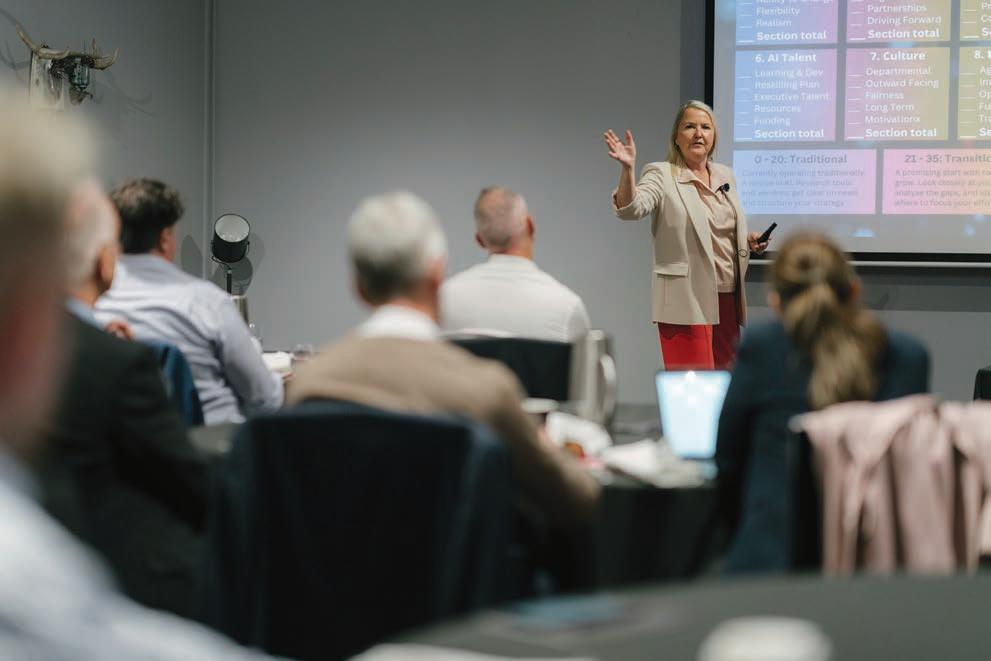
“How can we make sure that we are –on an ongoing basis – much more agile and innovative?”
Step 9 – Wider impact
“Councils should work with their think tanks and their trade bodies, and with each other. I’ve been really pleased to see many of the local councils in Australia and in New Zealand discussing collaboration, how they can come together and learn from each other. That’s so important.”
Step 10 -
“Do a strategic roadmap. Make sure that you have got the success criteria, the KPIs and so on in place for that.”
“For me, what this translates into is not a five year – or even a one year – business plan, but a set of activities that you can turn into a six-month plan that might have things like ‘which tools could improve which of our services? Could we meet with different stakeholders to discuss best practice? Could we look at how AI is being used in local government elsewhere? Can we do a small proof of concept in one part of the council?’”
“It’s important to break down the concept of AI into manageable parts to avoid overwhelming people,” Katie said.
“Start by analysing centralised services like HR, marketing and sales, and then create a taskforce to implement these innovations. The ultimate goal is for AI to solve problems and enhance the quality of life for residents, so local government needs to focus on identifying how AI can do that. It’s more practical to start with small integrations and adopt hybrid solutions.
“Setting realistic expectations and focusing on targeted areas where AI can have the most impact is crucial.”
At Datascape, we’re pioneering a councilfirst AI framework that empowers local government like never before. Our cutting-edge AI capabilities are designed to make a positive impact to everyday council operations and revolutionise service delivery. This isn’t just future thinking – it’s a transformative shift happening now.
If you’re interested in exploring how you can leverage AI with Datascape, or even test our capabilities for yourself, get in touch with us at datacom.com/nz/en/products/ datascape

Narromine Shire Council embarked on an ambitious project to enhance its infrastructure management using cutting-edge technology, including drones and laser scanning.
Faced with critical information gaps in their database that hindered planned maintenance works, Narromine Shire undertook a data collection project that aimed to accurately gather and reverseengineer data from existing buildings and structures.
The Council faced several initial challenges that prompted the adoption of this technology. Upcoming building maintenance projects required updated as-built details from past jobs, which were unavailable. Additionally, asset management data for some assets had limited attributes, making future
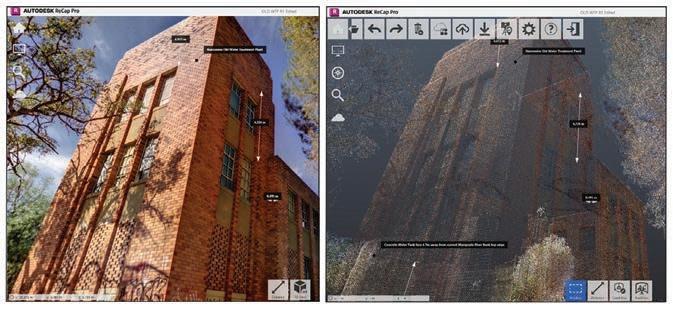
maintenance and upgrades difficult. For instance, while the location of a culvert was known, its accurate dimensions were not. Furthermore, level 3 bridge inspections required costly third-party consultants, leading the Council to develop in-house 3D model reviews to reduce costs.
Council selected Autodesk’s Recap Pro and Revit for data processing and plan generation, primarily due to their compatibility with locally available scanning tools like the Z+F IMAGER® 5016 scanner. These tools, part of Autodesk’s AEC collection, offered an integrated and efficient solution.
Drone technology enabled the engineering team to efficiently scan buildings and bridges, providing an accurate and comprehensive overview of their infrastructure. The drones captured detailed information previously

unavailable, significantly enhancing Council’s database.
Laser scanning technology was used to scan large bridges, culverts, and buildings. The results were highly accurate, addressing significant information gaps in the database. This technology proved essential for capturing detailed and precise data.
Once collected, the team used Autodesk’s Recap Pro to align and process the scanned information. The processed data was then imported into Revit, where plans were generated and dimensions were extracted with high precision. This workflow ensured the data was accurate and usable for various applications.
To ensure accuracy and reliability, the team meticulously followed the scanner supplier’s steps to create raw data point clouds and verified this data against known dimensions. For example, roof levels obtained from drone photogrammetry were cross-verified with the laser-scanned data model to confirm their accuracy.
During data collection, the team encountered challenges such as outof-range tolerances. They reattempted the Recap Pro indexing process and, in some locations, used the rescan option to ensure accurate data collection, maintaining the integrity of the data.
The collected data has been instrumental in several areas:
Asset Management: Accurate data is now a crucial part of Narromine Shire’s asset management systems. It provides reliable information for their geographical information system and asset database, ensuring efficient infrastructure management. For upcoming building maintenance projects, drawings generated by Revit serve as reference materials. Additionally, Recap Pro allows for dimension measurement in nonaccessible locations, further enhancing the accuracy and efficiency of asset management processes.
Planning: The data is also used for planning capital works and design projects. For instance, it has been crucial in redesigning a council building’s roof, providing detailed and accurate measurements. When a guardrail was damaged, the existing 3D model of the bridge provided detailed information that facilitated the investigation and design of a new guardrail for replacement.
Tendering: Accurate data has streamlined the tendering process for redesigning facilities. By providing precise dimensions, it has reduced the need for consultants and contractors to make assumptions, leading to cost savings and more efficient project planning.
Accurate data collection has significantly reduced the time
Autodesk required for consultants to perform investigative work. The need for additional subcontractors has been eliminated, leading to substantial financial savings of up to 30 per cent. The high accuracy of the collected data ensures that contractors can provide more economical quotations, reducing the risk of errors and leading to smoother project execution.
The increased data accuracy has led to measurable improvements in project outcomes and quality for Narromine Shire Council. The collection of asset data in a 3D model format provides multiple future uses, ensuring projects are executed with higher precision and reliability. This enhanced data accuracy has facilitated better decision-making and more effective project management.
Narromine Shire Council’s adoption of Autodesk solutions has revolutionised their infrastructure management approach. By leveraging drones, laser scanning technology, Recap Pro and Revit, Council has achieved significant time and cost savings, higher data accuracy and enhanced asset management. This case exemplifies the transformative potential of technology in public infrastructure management, setting a benchmark for other councils to follow.
To learn more, visit autodesk.com/au
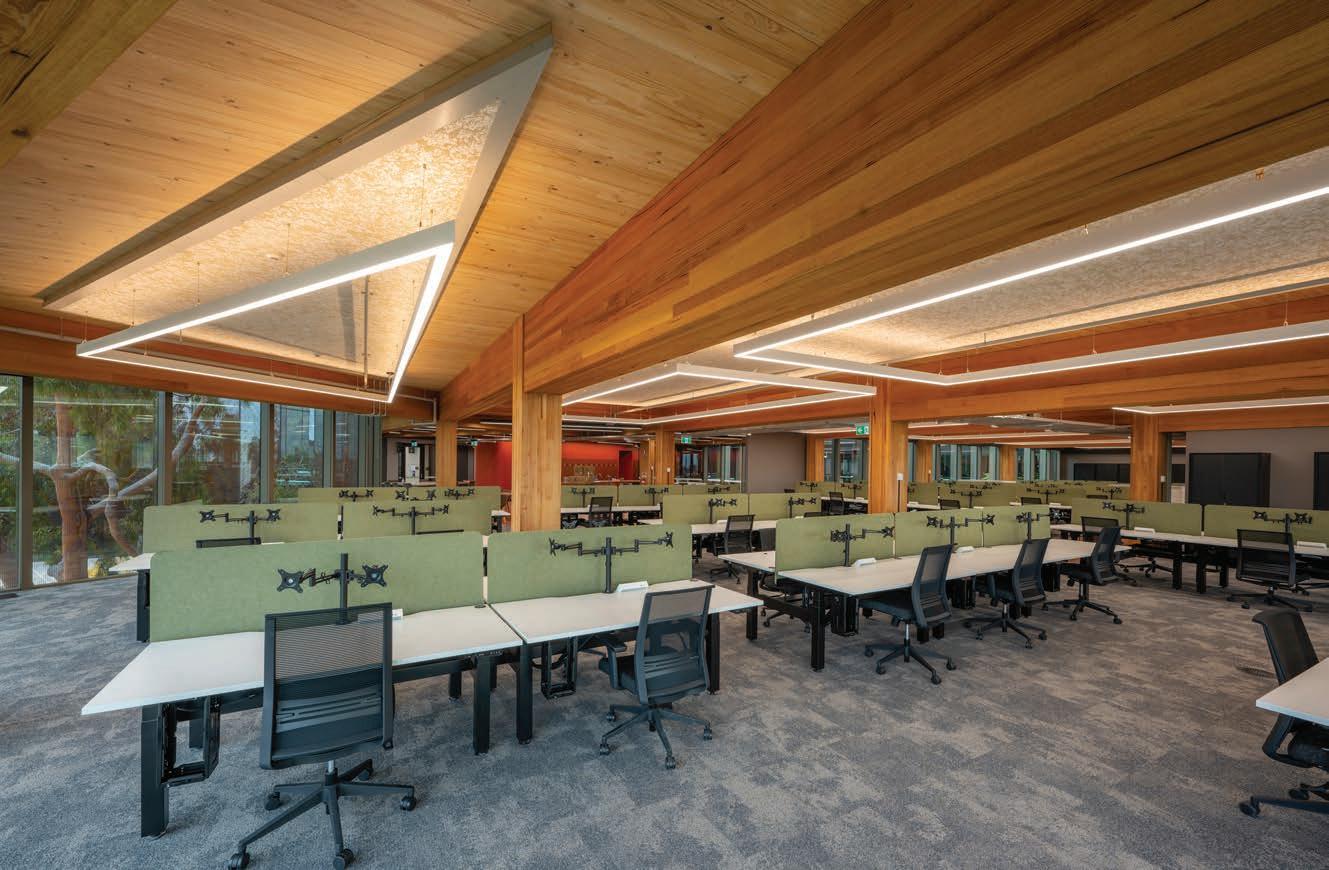
Timber features extensively internally, creating spaces that foster connection between people and nature.
With skills shortages occurring across a range of sectors, talent retention has never been more important. Ensuring that employees have a comfortable, aesthetic, high-quality space to work could be the key to attracting and retaining sta .
An increasingly high portion of Australian employees now spend their full working hours indoors, resulting in limited interaction with natural environments. This holds true for many council staff, particularly administrative staff working in government facilities and offices.
Recent evidence has shown that a lack of natural elements in the workplace – such as windows for natural light, plants, nature views, water features and wooden materials – can have a negative impact on worker satisfaction.
Studies have long shown the link between worker satisfaction and productivity, with staff that are
unsatisfied with their workplace found to be more likely to take unplanned leave days and generally be less productive. Additionally, unsatisfied employees are much more likely to search for other places of work.
These factors are why many councils are looking to develop new, modern facilities using timber and natural aesthetics to ensure the retention and productivity of valuable staff.
One such facility is the Galkangu – Bendigo GovHub, a $90 million construction project that provides a centralised location for the delivery
of government services in the Bendigo region.
The hub brings together around 900 City of Greater Bendigo and Victorian Government workers in a central facility in the heart of Bendigo. It is one of three recently constructed regional council offices to co-locate Bendigo City council officers.
The project brought 200 jobs to the local community, a $131 million boost to the local economy and provides a healthy environment for occupants and visitors.
The name of the hub and its front facade – which features the shield of the Dja Dja Wurrung Traditional Owners – are designed to evoke Bendigo’s rich Aboriginal heritage.

In 2021, then Premier Daniel Andrews, accompanied by Rodney Carter, CEO of the Dja Dja Wurrung Clans Aboriginal Corporation, announced the buildings name; Galkangu, which means ‘we make things happen together and are more connected to Country’.
The facility’s timber elements were delivered in partnership with XLAM, a manufacturer and supplier of sustainable, high quality, prefabricated Cross Laminated Timber (CLT) structures for Australia and New Zealand.
Sean Bull, Technical Sales Engineer NSW for XLAM, said that XLAM supported the project’s outcomes, supplying a total of 2,733m³ of XLAM CLT to the project along with its expertise, technical advice and support.
“As part of this support, we supplied the Galkangu – Bendigo GovHub with Victoria’s largest timber frame, an architectural landmark in the region,” Mr Bull said.
The sustainable mass timber design using XLAM CLT met key project drivers including:
• Environmentally conscious construction, using carbon reducing materials and methods
• Largest timber framed building in Victoria

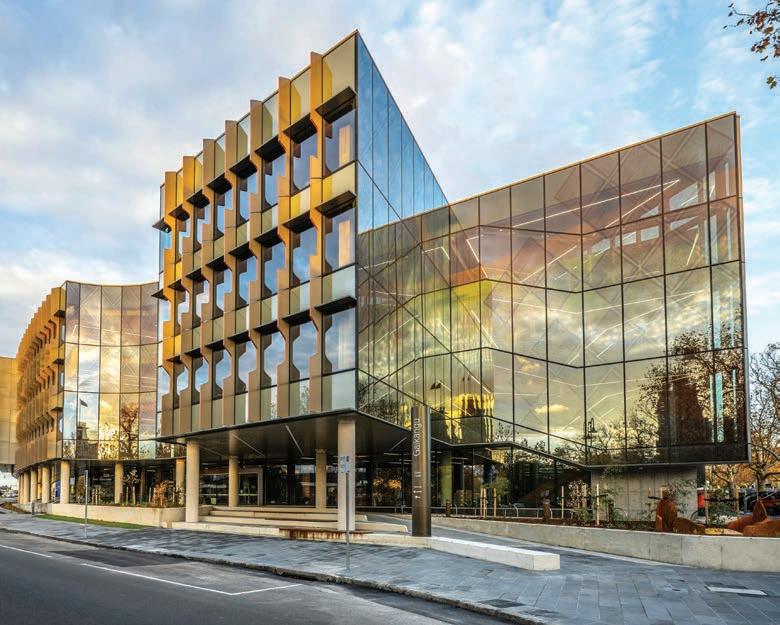

• Cost reduction from XLAM mass timber design expertise reducing expensive fixings
• Aiming to achieve six-star ratings for Green Design & As-Built Ratings and Nabers Energy Rating
• Exposed timbers with a Fire Resistance Level of 90 minutes
• Design reflecting Dja Dja Wurrung Culture
Celebrated as the largest timber framed building in Victoria, the hub is a landmark project that centralises the delivery of first-class government services to provide greater amenity to the community.
“People have an affinity for timber and natural aesthetics, something that is known as biophilia. Biophilic design is an approach that integrates natural elements into built environments, creating spaces that foster connection between people and nature,” Mr Bull said.
“Research published by Social Ecologist, Stephen Kellert has shown that workplaces that incorporate biophilic design principles experience improved performance, cognitive function and motivation, as well as reduced stress levels in their workers.”
Not only does the building’s timber construction and natural aesthetic contribute to a more comfortable workplace for hundreds of government staff, but the facility also provides a more
attractive location for constituents, delivering a better connection between council and community.
RENEWABLE RESOURCE
“XLAM’s CLT is manufactured locally from plantation pine grown right here in Australia. Endlessly renewable, the replanted trees also contribute to environmental goals by absorbing carbon from the air and locking it in the wood fibre,” Mr Bull said.
Timber has the lowest embodied carbon rating of all building materials, notably lower than steel and concrete. Timber locks more carbon in its fibre than is produced during its entire production process from forest to build site.
“For every cubic meter of XLAM CLT delivered to a construction site, approximately 492kg of carbon is removed from our atmosphere.”
By working with XLAM, councils can guarantee their facilities will be comfortable and pleasing to the eye, and improve the productivity and retention of their staff, all while contributing to greener building practices.
To learn more, visit xlam.co

When it comes to civil construction projects, councils require e ciency at every step of the way. Choosing the right software can make a world of di erence.
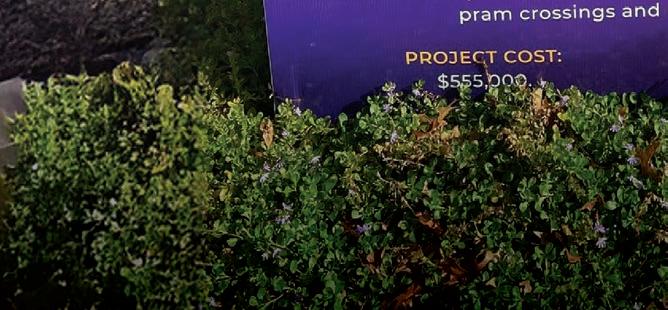
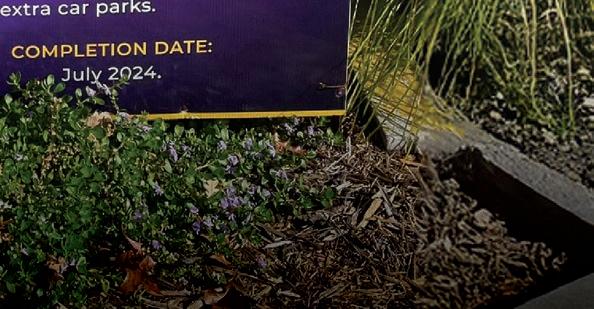
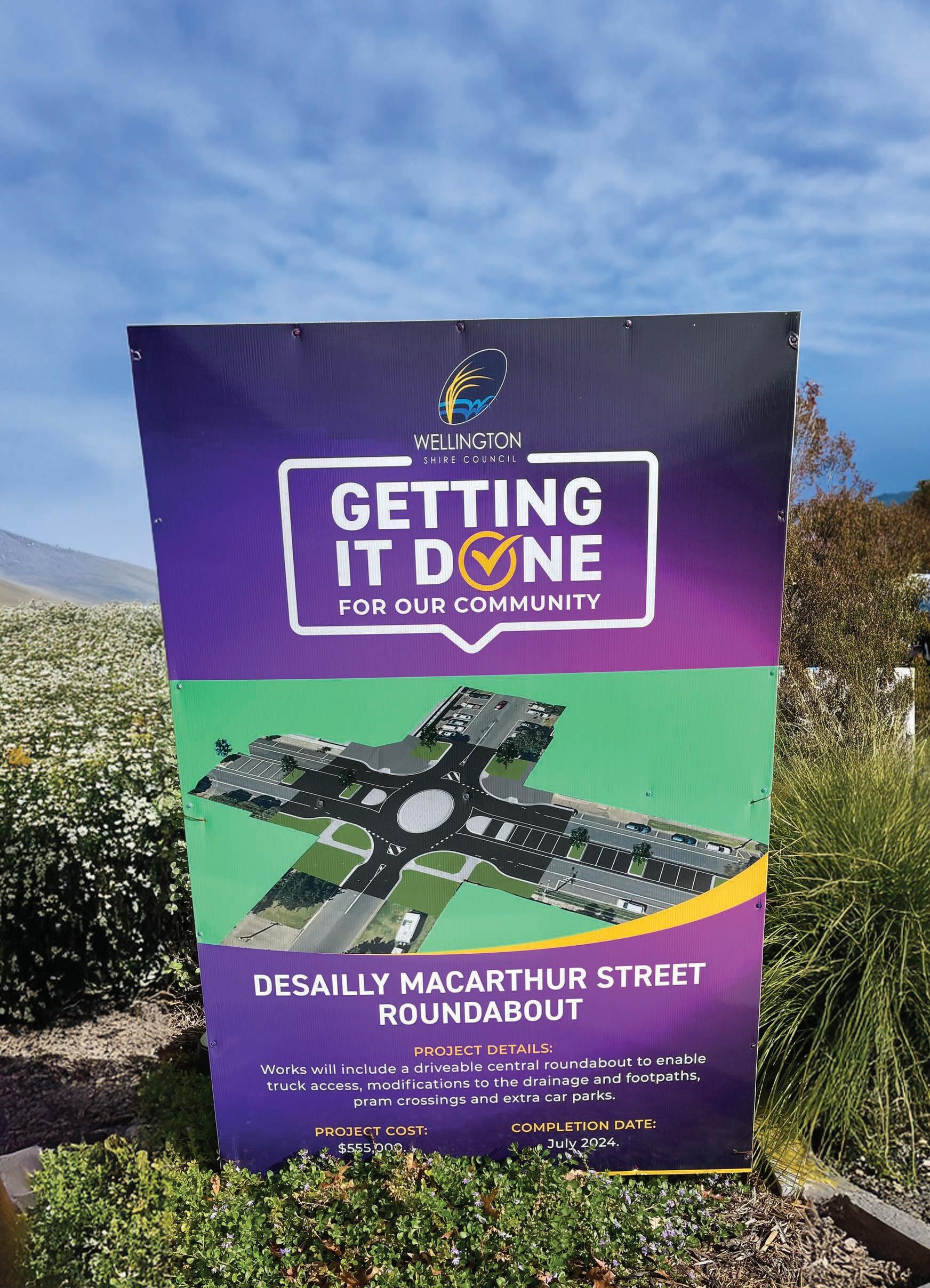
Local councils play a crucial role in maintaining local roads and infrastructure that keep communities connected.
From managing the day-to-day upkeep of local streets, executing road improvement works such as new roundabouts or splitter islands, to total road reconstructions and major earthworks, councils around Australia face an ongoing list of civil engineering challenges.
With so many moving parts, the key to success lies in the efficient management of these projects, ensuring they are completed on time, on budget and to the highest standard.
Efficient, accurate design tools are essential for councils to streamline these projects and managing their road networks effectively. The first step is finding the right software.
In 2024, Wellington Shire Council completed the Desailly Macarthur Street roundabout – a key project for the area to reduce accidents and improve traffic flow at one of the busiest intersections in Sale, Victoria.
The project included the replacement of existing drainage, footpaths, pram crossings and kerb and channel, as well as creating additional car parks.
And it was all made possible with Civil Site Design.
Civil Site Design is a modern, easyto-use civil engineering software solution for roads, road reconstruction, subdivision, earthworks, pipe networks and stormwater design.
Developed by Civil Survey Applications, the software seamlessly integrates with AutoCAD, Autodesk Civil 3D and BricsCAD and is accessed as part of the ribbon bar or toolspace.
Wellington Shire Council Lead Design and Infrastructure Development Engineer, Mitch Morelli, said this is one of the key benefits of using Civil Site Design.
“Most of the designers in our Shire use the Autodesk suite, so with Civil Site Design integrating into it, the software essentially operates the same way.
“This really helps with internal training and it means we don’t have to teach staff members an entirely new list of commands.”
With Civil Site Design, all design and drafting can be done within a single CAD drawing, and with the built-in 3D model viewer, all updates are made in real time. This results in less downtime
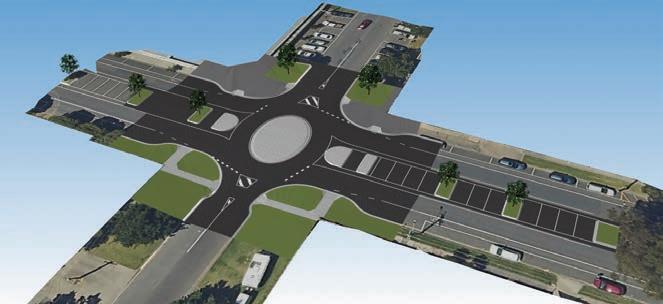
and greater design accuracy, enabling councils to get more done with fewer staff resources.
Mr Morelli said this feature had an additional benefit for the Council’s roundabout project.
“We were able to use the rendering from the software as our advertisement to the community for what the project would actually look like,” Mr Morelli said.
“It’s fantastic from that point of view – being able to use aerial imagery to show an accurate image of what it was going to look like at the end.”
The software also provides the opportunity to automate common design elements such as intersections, roundabouts and kerb returns with the assistance of artifical intelligence.
Importantly, Civil Site Design was designed in Australia specifically for the Australian road and civil engineering environment. Its string and template approach includes multiple ready-to-use road, kerb and batter templates, with default plotting output styles aligning with Australian standards.
“Being able to use the profile strings and constraints in Civil Site Design really helps us to integrate the project with existing areas,” Mr Morelli said.
“For the roundabout project, being able to see all of the centre lines on the road, the roundabout and the kerbs made a huge difference. I was able to individually tweak the levels through the island itself as well as in the parking bays where we removed some median and installed some additional parking spaces.”
With a local technical support team that understands your needs, free online training resources and the
Civil Site Design gives a clear view of infrastructure project design. Image: Civil Survey Applications
option for customised face-to-face courses and training, Civil Survey Applications will ensure you’re taken care of at every step of the way.
This has been a great help to Mr Morelli and the team and Wellington Shire Council.
“The online sources are amazing. There’s a video on almost every type of job you can do, which allows you to see how the software relates to the project you’re working on,” he said.
“I was able to teach myself to use the software purely from the videos.”
Civil Site Design is a complete civil package, offering flexible, costeffective licensing options, including both perpetual and network licenses, making it an ideal choice for councils operating on tight budgets.
“With Civil Site Design, I can do everything I need to do with just the one upfront purchase,” Mr Morelli said.
“With other software solutions, you often have to pay for everything extra you want to use. But with Civil Site Design I can do my full civil and drainage design straight up.”
Mr Morelli said that as the cost of external designs continues to rise, the value of Civil Site Design continues to grow.
“With Civil Site Design we’re able to get three or four licences for a cost equivalent to one external design. It’s incredible cost-effective.”
Its affordability, ease of use and modern features make Civil Site Design the go-to design solution for more than 120 councils nationwide.
Civil Site Design is the perfect tool for councils seeking efficiency, simplicity and accuracy in their civil engineering projects.
To learn more, visit civilsitedesign.com.au
By Kevin Wilton, Team Lead Integration, Brightly Software
Digitisation is a hot topic in councils across Australia, but it’s crucial organisations take an integrated approach to ensure success.
Ask any local council if they’re on a digital transformation journey, and the answer is more than likely to be yes. According to McKinsey research, around 90 per cent of all organisations are undergoing some kind of digital transformation.
However, as councils embrace new technologies, individual departments often adopt tools to address specific requirements, which can result in isolated systems, fragmented workflows and data silos. The key to resolving these challenges lies in enabling these various systems to talk to each other. By integrating data and processes, councils can improve accuracy, enhance efficiency and unlock value and continuous improvement at scale.
The topic of integration often arises during digital transformations when councils need to upgrade their Enterprise Asset Management (EAM) system while ensuring it fits in with existing systems and workflows – such as ERP, CRM and GIS.
One challenge is enabling existing apps and the new EAM system to interface to one another. This is where Application Programming Interfaces (APIs) come in. APIs provide a standardised way for different applications to communicate with each other, regardless of the underlying technologies or platforms used. This
and functionality in a consistent and predictable manner.
Today, APIs are crucial to managing large-scale and complex operations, including incorporating EAM into the application ecosystem and business processes. There are several advantages of an EAM integration, including simplified workflows, having the right tools for the job, data confidence and reporting aligned to requirements.
Start by looking at your business requirements and not the software challenge. What information do you need to flow from one system to another? How urgently do you need the data – in near real-time, overnight, or periodically?
Here are some examples of when to integrate:
• Highly frequent transactions, such as customer request information going to your maintenance department
• When the integration is well understood, such as when actioning a customer service request that requires data to flow from your EAM to your maintenance system and GIS
• Where there’s a risk of data errors, such as when having to enter data into multiple disparate systems.
Spend time understanding your needs first before working out the ‘how’. In some instances, integration may be unnecessary, or the cost may outweigh the benefit, so it’s important

Integrating an EAM system with other software systems is not without challenges, but there are strategies to help overcome these hurdles.
Engaging vendors early in the integration process can help clarify requirements and secure the necessary APIs and documentation, making the process smoother and more efficient. It’s also crucial to foster internal collaboration during the integration process. Ensuring alignment between IT departments, senior management and end-users can minimise misunderstandings about the new system’s capabilities and potential. Clear communication about goals, timelines and technical requirements can also prevent integration projects from stalling.
Integrations can be completed by your IT team or a collaboration – it doesn’t have to be prepared by one vendor alone.
In-house integrations can utilise advanced whole-of-business integration frameworks, whereby a new application is ‘snapped’ into the framework. Or vendors can provide an integration, allowing you to utilise their experience with their app and the apps commonly integrated with it. And in some instances, two vendors with complementary apps may work together to provide an integration.
Achieving the full benefits of an EAM solution as part of a digital transformation often hinges on effective integration strategies. By identifying the right opportunities for integration, aligning internal and external resources and overcoming common challenges, organisations can ensure their EAM solution delivers ongoing value.
To learn more, visit brightlysoftware.com/integrations

If you’re among the many local councils undergoing digital transformations, upgrading your Enterprise Asset Management (EAM) solution and ensuring it fits in with existing systems and workflows is essential. By streamlining data and processes, work can be performed more accurately and efficiently while creating value and continuous improvement at scale.
Achieving the full benefits of an EAM solution often hinges on effective integration strategies. By identifying the right integration opportunities, aligning internal and external resources and addressing common challenges, you can ensure that your EAM solution delivers maximum value.
Learn more at brightlysoftware.com/integrations






As governments, organisations and individuals around the world grapple with the need to decarbonise, Ipswich City Council is leading the way, meeting ambitious organisational targets.

Akey goal – to halve council’s Scope 1 and 2 generated carbon emissions within five years – will be achieved thanks to innovative, collaborative and clever problem-solving, resulting in an 85 per cent renewable energy output and a 14,000-tonne yearly carbon dioxide reduction.
Determined to make a difference when it comes to its carbon footprint, council saw an opportunity to offset the running of more than 29,000 streetlights, plus a huge catalogue of infrastructure including an eight-storey administrative building for more than 800 staff.
In a three-year timeframe, council has reduced its emissions from electricity (Scope 2) by approximately 85 per cent (Scope 1 emissions refer to direct greenhouse gases from sources owned
or controlled by council, while Scope 2 emissions refer to indirect emissions from the generation of purchased electricity, steam, heating, and cooling consumed by the organisation).
The South East Queensland council established the 50 per cent emissions reduction by 2026 as part of its Sustainability Strategy 2021-2026. The target includes direct emissions for council-owned sources like transport fleets and, importantly, electricity used by council to run its operations.
HERE’S WHY
Ipswich has a history of natural disasters, particularly the floods of 1974, 2011 and 2022, as well as severe storms and drought.
In the most recent disaster in 2022, almost 600 homes went underwater,
leading to nearly 300 being bought back, the houses demolished and the lots to now be rezoned to green space –ensuring hundreds of families will never be flooded again.
Like every other city in Australia, Ipswich needs to be cleaner and greener, and has a clear vision to become a sustainable city - not an easy task as one of the nation’s fastest-growing cities where the population is expected to double to 535,000 residents by 2046. Council has to lead the way and this is highlighted by its sustainability strategy, with one of its key tenets being for council to lead by example when it comes to sustainability, with the additional goal to inspire and support local businesses and residents to undertake their own sustainability efforts.
Ipswich City Council has o set the carbon emissions of its 30,000 streetlights.
“(By) the decisions and the activities we undertake as an organisation every day – the energy and water we use, how we minimise our waste, and the purchasing decisions we make as a council – we can achieve best practice in sustainability,” the strategy reads.
Years prior to the sustainability strategy coming into effect, as it focused on how to reduce its emissions, council determined that a power purchase agreement (PPA) should feature as part of the mix of actions to reduce emissions. The opportunity to negotiate a PPA came up in 2023.
With the help of a consultant with experience in brokering energy contracts, council went to market to find an energy provider that could meet
council’s requirements – powering some 29,400 streetlights, council’s main administrative building, Ipswich Children’s Library, Ipswich Central Library, Ipswich Civic Centre, Ipswich Art Gallery and two council depots.
What followed was a rigorous procurement process involving an initial market offering and shortlisting before establishing the best offer.
Council awarded the 7.25-year contract to CleanCo Queensland – a publiclylisted company based at Swanbank in Ipswich.

CleanCo met the requirements for providing renewable energy, sourced from wind farms at Dulacca in the Western Downs and Kaban in the Tablelands – a truly Queensland initiative. Sourcing from genuine renewable energy projects located
within Queensland was a key criterion of the agreement.
Council will consider options for the remaining 15 per cent of non-renewable electricity requirements when the contract comes up for renewal in 2026 as we continue to map the path towards being a low-emission organisation.
The 28 wind turbines at Kaban and 43 at Dulacca produce a combined amount of energy to power around 200,000 homes collectively each year.
Council’s contract with CleanCo enables it to buy clean energy generated at these facilities through large-scale generation certificates. These certificates represent one megawatthour (MWh) of wind-powered energy produced and put into the power system.
The result is that approximately 85 per cent of Ipswich City Council’s electricity use is now renewable, or about 20,000 MWh.
While the shortfall is made up by traditional energy forms, it’s a reduction in Ipswich’s carbon footprint by approximately 14,000 tonnes of CO2 per year.
Council is incredibly happy with its partnership with CleanCo – and not just because it’s an Ipswich company.
At the time, only two other councils in Queensland (Brisbane City Council and Cairns Regional Council) had signed PPA contracts.
Through initial assessment, the PPA has been forecast to be cost-neutral or potentially financially beneficial to council when compared to projected electricity price increases over the life of the seven-year contract, reducing costs on electricity.
Since implementation of the PPA, council has shared knowledge via the South East Queensland Climate Resilient Alliance (SEQCRA) and to individual councils who are interested in implementing their own renewable energy contract and reducing their associated emissions from electricity.
Procurement company Local Buy has also stated it is now looking at opportunities relating to PPAs.
Ipswich City Council is looking to expand upon its work to make its operations more energy efficient, beyond the goal to cut its carbon footprint by 50 per cent by 2026 which does not include emissions
from non-council-owned sources, such as those produced by contractors or third-party service providers (Scope 3).
An example of this effort was a recent project to replace more than 600 lights at the Ipswich Art Gallery with energy-efficient LED alternatives, which has already resulted in a fall in energy consumption and energy costs for the heritage-listed building.
Council has also installed several rooftop solar photovoltaic (PV) systems on several of its facilities and has a strategic plan to roll out further installations throughout the coming years.
Notably, an installation is scheduled at the Ipswich Central Library this year, which is expected to result in an emissions reduction of more than 200 tonnes of CO2 per year. These types of energy saving projects not only reduce council’s organisational emissions but also provide an attractive return on investment.
Additionally, council has also set up an internal sustainability working group to help deliver and promote environmental awareness and sustainability practices across council’s 1,500-strong total workforce.
SEQCRA was formed to enhance the capacity of local government teams through collaboration on projects, advocacy and knowledge sharing to achieve regional solutions to climate risks.
Ipswich City Council currently hosts the alliance, providing in-kind support through HR, procurement, legal and

to the demands of climate change, accelerate the region’s transition to net zero and ensure a climate resilient future.
The alliance has been formed to enhance the capacity of local government teams through collaboration on projects, advocacy, knowledge sharing and grant submissions to achieve regional solutions to climate risks.
Ipswich City Council acknowledges that sustainability is not a singular issue, but rather a complex and interconnected challenge across environmental, social and economic factors, recognising several key focus areas around sustainability, transport, climate adaptation, the natural environment and circular economy.
Various projects being undertaken by council to align with the desired outcomes of the sustainability strategy.
in Ipswich has a garden organics bin, minimising waste to landfill.
We will continue urban greening plantings in priority suburbs to help reduce heat by increasing canopy cover.
Council’s Enviroplan protects about 6,700 hectares of land, most of which was purchased through a ratepayer levy over the past 29 years. It is vital protection in a city with no national parks.
The Voluntary Home Buy Back scheme has led to nearly 300 homes being bought back in the highest flood risk areas and houses removed or demolished with land now to be rezoned as green space for the community.
With council’s 2024-25 budget allocating $13.7 million for environment and sustainability initiatives, it will continue to explore options around



Every sporting champion started as a little spectator. It’s why having the high quality, inclusive spectator facilities at your sports grounds matters. Felton can help.
Our versatile grandstands mean everyone can be inspired by their heroes - starting from just $1,999.
So, everyone gets a view


The water industry has been searching for renewal solutions specifically optimised for pressure pipelines. Pipeline infrastructure specialist, Interflow, shares how it developed a suite of sustainable renewal solutions to address this growing need.
When it comes to ageing water infrastructure, pressure pipes have traditionally been excavated for repair or replacement. This has disrupted communities and increased costs and time scales.
As corrosion from aggressive soils attacks underground pipes, a trenchless renewal option becomes increasingly attractive.
“Proactive trenchless renewals are one of the keys to defending our critical water and wastewater services in a sustainable and cost-effective way,” said Will Zillmann, Interflow’s National Product Manager.
Comprehensive renewal solutions should not just fix a specific problem, but should reset the lifespan of the pipeline. They should essentially perform as a new product.
“Our objective was to build a suitable suite of proven solutions that enable us to match the right product or approach to the pressure pipeline’s condition, material, size and location,” said Mr Zillmann.
At the core of Interflow’s suite of solutions is a polyethylene liner technology known as Titeflow.
It’s a structural liner that has its diameter reduced with a die during installation, so it can be drawn into the host pipe. Once inside, it expands again to press against the host walls, creating a new pipe within the existing pipeline.
As a lining technology, it fits within the ISO classifications for trenchless solutions, primarily at Class A (can survive failure of host pipe and is a fully structural solution).
It’s a solution that balances performance, safety and environmental impact. As the triple bottom line of environmental, social and economic impacts becomes increasingly important to water authorities and government, sustainable pipeline renewal methods will become the norm, said Mr Zillmann.
Interflow’s purpose is to improve lives, which extends to the communities and environments they operate within. This has led them on a journey to find, assess and develop renewal solutions that are sustainable and support the needs of the industry, customers and their communities.
On this journey, and to ensure the trenchless solutions do what they promise, Interflow ran an exhaustive and ongoing research project. Through such research projects, and by working closely with customers, Interflow has been able to push the boundaries of common approaches like slip lining and large diameter die-reduction lining.
“For example, we’ve had success renewing longer lengths of water main
using both of these technologies by thinking differently about how we store, string out and weld pipe sections, and how we facilitate insertion,” Mr Zillmann said.
“We can now offer renewal options for pressure pipes in varying condition states and covering a large range of sizes and materials.”
“Our approach to renewal opportunities has always been to be solution-agnostic and develop an optimal methodology based on project-specific network capacity needs, pipe condition and material, internal diameter, access constraints, budget and community needs.”
To learn more, visit interflow.com.au

To e ectively inspect sewers to modern standards, local governments need to ensure all their tools work together seamlessly.
Ageing pipes, unexpected overflows and water infiltration can lead to costly repairs and disruption to communities. That’s why it is so important for councils to complete sewer inspections regularly, effectively and having the right tools for the job is critical.
Sewer inspections are complicated operations that require a range of tools from robotic inspection devices (hardware / cameras) to asset management software and a variety of other supporting technologies.
Councils that can find a one-stop-shop supplier for their sewer inspection needs will realise significant procurement benefits for their operations.
Sewer Equipment Company (Aust), better known as SECA, has been around since 1967 and is recognised as the leading supplier of sewer maintenance equipment and after sales support across Australia and New Zealand.
Over the past 20 years SECA has built up industry leading partnerships with
world-class suppliers including iPEK, WinCan and Envirosight.
In 2009 IDEX Corporation (a large USbased water organisation) acquired iPEK and has since also acquired WinCan and Envirosight, creating a holistic approach to hardware and software.
iPEK – leading manufacturer of sewer inspection technology
Widely regarded as the benchmark for crawler camera system worldwide. With a dedication to innovation and exceptional service, iPEK provides highperformance robotic inspection systems
fulfilling the pipe inspection needs of council sewer engineers/managers.
iPEK’s robotic pipe crawlers go where they need, and their advanced manoeuvrability lets them navigate complex systems with ease. Thanks to the intuitive touchscreen controls, iPEK’s crawlers are easy to operate.
iPEK’s devices are highly adaptable, with easy-to-change wheels, elevators and undercarriages allowing them to meet the needs of any given operation, saving time with quick changeover and minimal tools in the field.
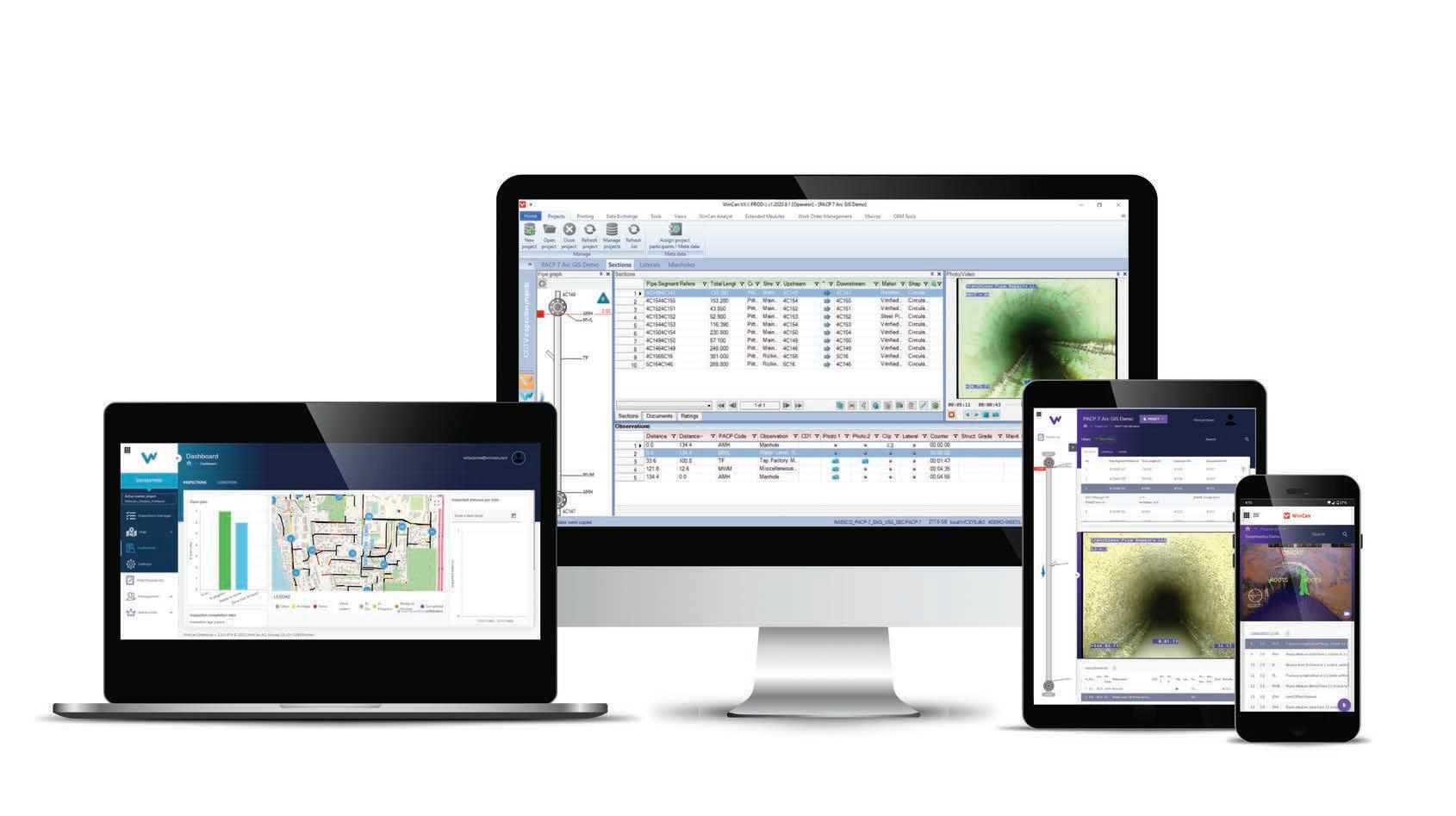


asset management software that turns inspection data into actionable insights, making it easier to plan, prioritise and budget for maintenance.
The software makes it easy to collect, analyse and report inspection data. With AI-powered, cloud-based solutions and seamless GIS integration, WinCan is the industry’s preferred sewer inspection software, with an installed base of more than 8,500 licenses worldwide.
WinCan provides a suite of data management modules that allows different parties to collaborate in the management of their wastewater infrastructure. The data analysis solutions can identify trends, pinpoint hotspots for prioritised maintenance and even forecast budgets in a cloud-integrated, AI-supported inspection environment.
WinCan’s extensive suite of reporting and data visualisation tools creates a single source of information that lets network managers glean operational insights in many aspects of sewer management.
Envirosight – cutting edge wastewater inspection technology including manholes
Envirosight has opened the door to manhole inspections. Delivering a wide range of innovative sewer
inspection technologies designed to make inspections faster, easier and more effective.
Envirosight’s equipment boasts low cost of ownership, with rugged, versatile hardware that minimises wear and tear.
These acquisitions by IDEX Corporation have strengthened SECA’s market position as market leader, continuing to set the benchmark in bringing world-leading inspection and asset management technologies together to help councils stay ahead of the curve.
The key to IDEX’s offering is having all the hardware and software offerings under one umbrella.
SECA then provides the localised support in terms of training, sales, stock and aftersales support.
This simple holistic approach to asset management and inspections empowers operators, engineers and managers to make data driven decisions, assisting in workload prioritisation and budget management.
To learn more, visit seca.com.au
With floods wreaking havoc across Australia, the federal and state governments are investing significantly in new infrastructure that will improve the flood resilience of their communities.
Flood resilient infrastructure is a must for many local governments.
To take full advantage of the disaster preparedness funding made available to them by the government, councils require reliable and durable solutions that provide long-lasting functionality.
Resilient infrastructure is about more than creating strong, lasting assets. It’s about protecting communities and ensuring that vital services remain accessible, even when disaster strikes.
Box culverts offer a robust, costeffective option for various civil
engineering applications and are a great choice for councils looking a versatile flood management solution.
Box culverts are a type of drainage structure used to channel water away from or underneath roads, railways and other structures.
Their distinctive rectangular shape provides superior load-bearing capacity, making them suitable for high-traffic areas. These culverts can be used in a range of flood control applications, including to protect highways and railways, in stormwater management systems and even river crossings.
One of the primary features of box culverts is their durability. Made
from high-strength concrete, box culverts are designed to withstand harsh environmental conditions and heavy loads. Whether it’s vehicle traffic, floodwater or shifting soil, box culverts are in for the long haul, specifically engineered for endurance to ensure minimal maintenance costs and reduced risk of failure.
Local government budgets are tight, so squeezing as much value as possible out of funding is a must for all councils.
Box culverts provide an affordable solution that minimises both up-front costs and long-term maintenance expenses. Their high durability and low upkeep reduce costs over the asset’s

Civilcast’s box culverts are a reliable choice.

lifecycle, offering a significant return on investment.
RIGHT SOLUTION, RIGHT PROVIDER
Councils want to turn their funding into great outcomes for their communities, so finding a provider that is committed to adhering to the highest industry standards is vitally important.
By choosing a supplier whose box culverts are designed and manufactured in accordance with Australian Standards, councils can ensure that their projects meet the safety and flood protection needs of their communities.
Civilcast is an experienced manufacturer and provider of a wide range of precast and steel products for civil construction and infrastructure projects. Civilcast’s box culverts are a reliable choice, providing strong, economical and custom-made solutions for stormwater drainage and flood management infrastructure across Australia. Every area is unique, and Civilcast understands that one-size-fitsall solutions won’t always cut it.
Whilst Civilcast does stock a range of standard size culverts it does also offer custom solutions where the box culverts can be tailored to specific design requirements, whether for varying lengths, widths or custom configurations to suit particular site conditions. Their flexibility makes them an ideal choice for a wide range of applications and projects that local governments manage.
Civilcast’s box culverts are pre-cast and manufactured at their state-of-theart manufacturing facility in controlled factory conditions. This ensures uniformity, which in turn guarantees that every culvert is a strong, highquality product.
Precasting also reduces on-site labour, reducing both installation times and costs when compared with cast-inplace alternatives.
The standard sizes allow for easy handling, and installation typically requires minimal specialized equipment. This reduces the time spent onsite, greatly reducing disruptions to communities and accelerating project completion.
With the government setting major sustainability targets for councils, it is important to consider environmental impacts when designing infrastructure.
Civilcast’s box culverts are produced using eco-friendly practices, including sourcing raw materials responsibly and minimising waste during manufacturing. Additionally, the long lifespan of these culverts reduces the need for replacements, contributing to more sustainable infrastructure. They are also available with precast base slabs, which further reduces construction times.
Civilcast has a Global-Mark Certification to ISO9001, so local governments can rest assured that they are partnering with a provider that is reliable and delivers highquality products.
With a range of standard sizes or a custom, tailor-made solution – all manufactured to Australian Standards (AS1597) – Civilcast can provide councils with resilient, long-lasting assets that fulfill their needs.
To learn more, visit civilcast.com.au
As a local council, you need to respond proactively to a changing world — with limited budgets and often incomplete information. By rethinking your digital capabilities today, you'll be able to use data to help you face these challenges, while driving the best possible outcomes for the citizens you serve.
A digital view of your physical estate lets you focus budget, make informed decisions, and communicate transparently with citizens.
Spot trends in citizen usage, speed up construction projects, and amp up your ability to respond to changing needs.
Build energy efficiency into the whole lifecycle of a building, from design to operation.
Get started today

boards.autodesk.com/anz-lga
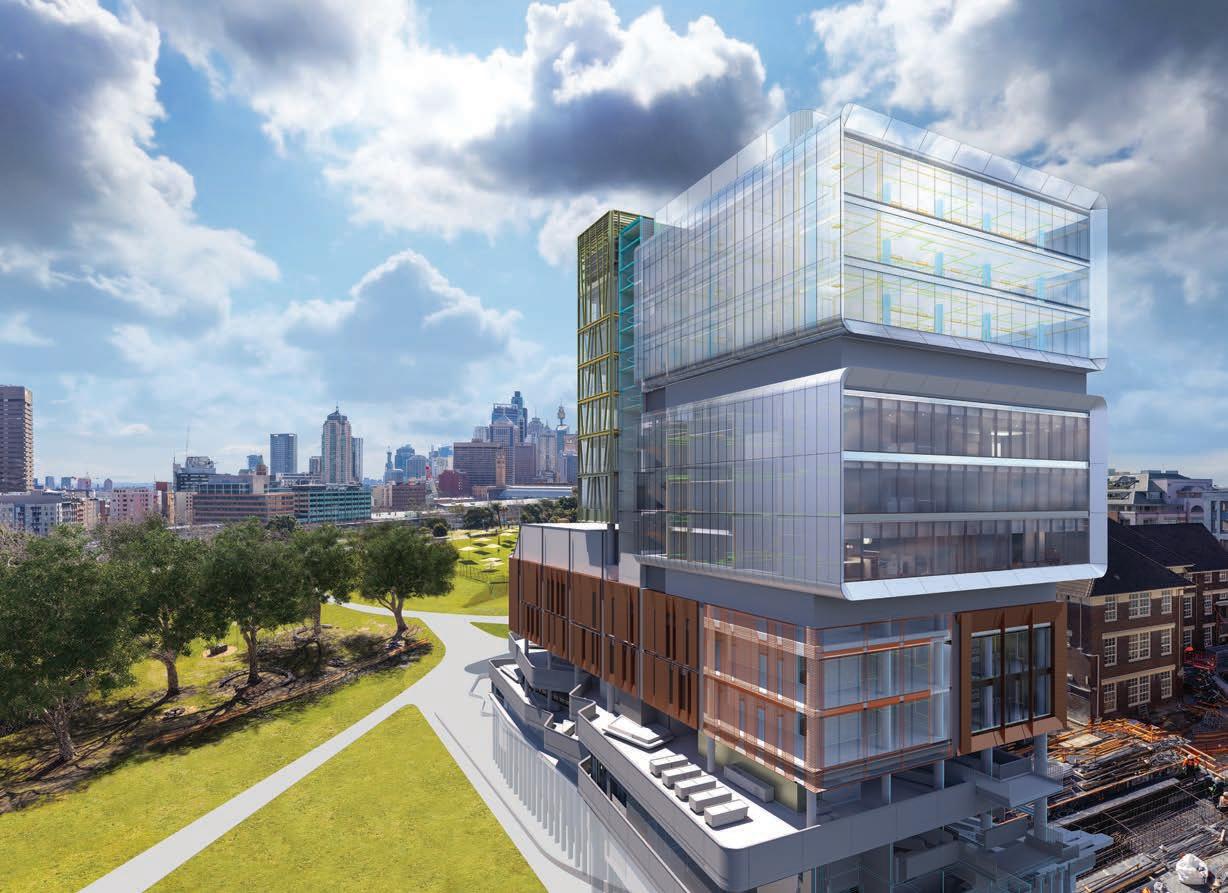


ccording to a New South Wales government research report titled Automated Decision-Making in NSW, computer vision is being used across various government services, with notable
•Counting swimming pools and assessing rooftop solar panels
•Identifying issues in water
•Enhancing public safety through
These diverse applications highlight the transformative potential of computer vision technology in modernising government operations and service delivery. In this context, the City of Greater Geelong is setting a new benchmark by leveraging advanced technology, data analytics and AI to drive innovation in pedestrian and road safety.
Traditionally, assessing road safety at high-risk intersections involved manual surveys where data collectors would physically observe and record traffic and pedestrian behaviour. This method, while useful, is labour-intensive and
As new technologies like artificial intelligence begin to permeate the public sector, both in Australia and internationally, councils can transform the way they deliver services and keep communities safe.
provides only intermittent snapshots of traffic conditions. It also struggles with capturing data during off-peak hours or adverse weather conditions, limiting its effectiveness.
Computer vision offers a transformative approach. By utilising AI to analyse digital images and videos, computer vision systems can continuously monitor and assess traffic and pedestrian behaviour, significantly enhancing the ability to deliver a more accurate and complete understanding of local conditions.
Computer vision technology for traffic and pedestrian movement involves several processes, including object detection, tracking and categorisation. The system starts with high-resolution cameras strategically placed at key locations to capture continuous video footage of the environment. Sophisticated algorithms trained on diverse datasets are employed to detect and classify various objects within the footage such as cars, heavy vehicles, bicycles and pedestrians. The system’s ability to accurately categorise these objects enables monitoring and analysis of traffic and pedestrian behaviour.
Once objects are detected and categorised, the system tracks their movement from frame to frame in real time, analysing their speed, direction and movement patterns. By analysing these trajectories, the system can identify potential hazards, such as a vehicle approaching a pedestrian crossing or a community member stepping into the crossing outside the designated area. The categorisation of objects allows detailed reports and insights, such as traffic density by vehicle type or pedestrian traffic patterns. This data is invaluable for optimising traffic management, enhancing safety measures and informing urban planning decisions to improve overall traffic flow and pedestrian safety.
Near misses can be identified by analysing instances where objects come extremely close to each other without resulting in a collision. Using spatial and temporal data, the system evaluates the proximity and movement patterns of objects to estimate the likelihood of potential accidents. Insights gained from these near misses enable the identification of high-risk scenarios, providing valuable data to refine traffic management strategies and mitigate potential hazards. This method supports detailed safety assessments and
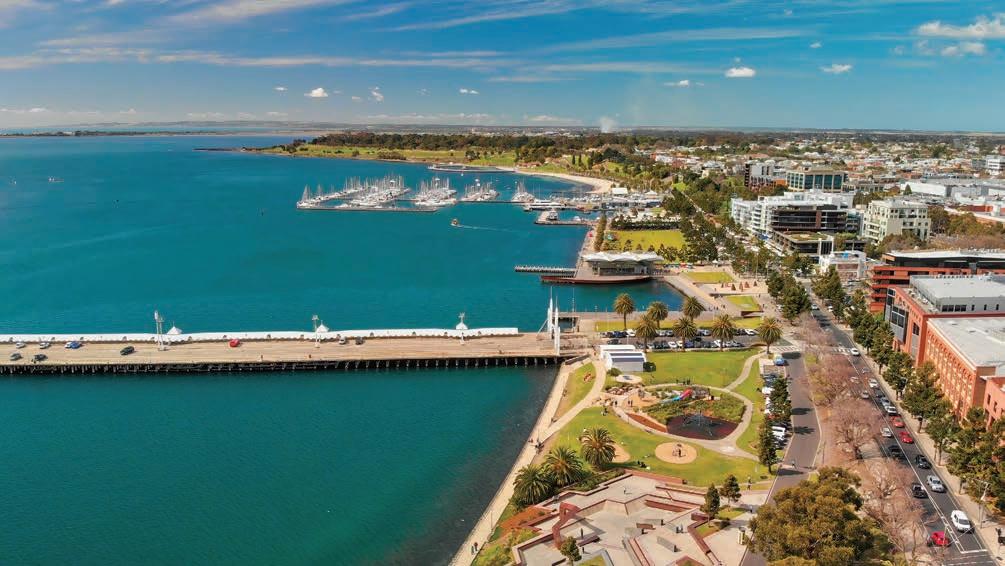
enhance pedestrian safety and optimise overall traffic flow.
The city deployed a sophisticated computer vision solution for traffic analysis and monitoring at the Ginn Street and Western Beach Road intersection on the Geelong Waterfront. This location was identified as a high-risk area due to anecdotal feedback reporting frequent near misses at the pedestrian crossing. When using this technology, a crucial step is defining within the image frames the key capture points and areas, known as gates and zones. Virtual gates represent where data on pedestrian and vehicle movements will be collected including the type of object (e.g. car, motorcycle, pedestrian) and its trajectory.
Gate 1 (Ginn Street Entry) and Gate 3 (Ginn Street Exit) monitor positive direction traffic, recording 214 and 178 entries and exits respectively. Gates 6 and 7 monitor Western Beach Road traffic, with a significant number of entries and exits (4,825 and 3,855 respectively). Gate 5 monitors pedestrian traffic in both directions with 209 entries and exits. Zone 4 has a total of 9,062 entries and exits. Notably, there were no near-miss incidents recorded during this time period.
A video feed of the mobile unit, recorded between 10:00 and 11:00 on 16 August 2024 recorded 155 objects in the south direction, with a significant majority being cars. The north direction recorded 121 objects, also predominantly cars.
pedestrian crossing were also recorded over a 40-hour period. Each near miss is logged, with unique identifiers assigned to individual incidents. The safety indicator values provide a quantifiable measure of risk, with lower values signalling more dangerous interactions between objects at the intersection. The precise timestamps offer insight into the timing and frequency of these events, enabling targeted interventions. By analysing this data, the city can better understand the dynamics at this intersection and implement strategies to enhance safety, such as traffic signals, improved lighting or redesigning pedestrian crossings.
Computer vision holds immense potential for enhancing safety, reducing accidents and protecting lives. The city’s experience has provided valuable lessons for other local governments seeking to use computer vision for road safety and road-based applications.
Key takeaways include:
1. Perform comprehensive site assessments to evaluate the intersection layout, analyse traffic patterns and determine the most effective sensor placement locations
2. Ensure the AI is configured correctly to focus on capturing high pedestrian traffic areas and integrate insights into decision-making processes as early as possible
3. Balance data costs by prioritising data feeds, while ensuring data is comprehensive and continuous for a complete traffic overview
4. Utilise data insights to inform infrastructure changes, thereby improving pedestrian safety measures
The city’s 2024-29 Organisation Strategy highlights its forward-looking commitment to leveraging digital and data foundations.
This approach extends beyond road and pedestrian safety. For instance, the city is embracing technology like rainfall sensors, enabling more effective responses to localised weather-related events and improving its ability to manage stormwater efficiently, reduce flood risks and strengthen overall infrastructure resilience.
Other examples include the use of high-fidelity 3D building and tree models, which allow for more simulations of the urban environment. These models are important for planning future growth and promoting environmental sustainability more effectively.
As the City of Greater Geelong continues to embrace the possibilities of digital and data-driven solutions, its commitment to innovation raises intriguing possibilities for the future. What if advanced technologies like computer vision could be further integrated to not only enhance pedestrian and road safety but also transform the way cities address challenges across all sectors? Geelong’s innovative mindset goes beyond solving today’s challenges – it’s embracing a ‘what if?’ perspective to build a forward-looking future where technology positively influences how Council leadership makes data-driven decisions, engages with communities and creates sustainable, inclusive urban spaces.
When selecting products for your next school addition, choosing a responsibly sourced lower-carbon option is the responsible choice on the path to a more sustainable future. LocAl® Green (8kg CO2e/1kg AL*) and LocAl® SuperGreen (4kg CO2e/1kg AL*) aluminium offers significantly reduced embodied carbon compared to the global average and are available across Capral’s range of aluminium seating and manufacturing solutions.


To better plan and utilise their budgets, local governments need insights into the needs of their communities.
Councils are constantly planning the expansion or enhancement of their suburbs and infrastructure, such as building new roads and connections, reducing traffic congestion, connecting more services and utilities, providing better transport corridors, or enhancing safety for both motorists and pedestrians.
Planning in communities is most efficient when based on accurate information on community behaviour, leading to infrastructure and services that align best with ratepayer needs and experience. Secure Agility Product Manager, Ahmed Abdeldayem, explained that councils need to understand exactly what is happening in their communities, where, when and how frequently.
“Let’s say for example that a council wants to make some improvements for a school which suffers from massive bottlenecks at pickup and drop-off times. How would they know exactly what’s happening, traffic numbers, congestion times, and even things that could jeopardise people’s safety, like near-misses or accidents?
“They need to collect insights,” Mr Abdeldayem said. “This is where smart systems can watch over specific areas that are planned for development or an area where the council is sceptical about planning development because they don’t have enough knowledge.”
By utilising AI-powered systems, councils can monitor targeted areas 24/7 and gain valuable insights. A human worker does not have to trawl
Secure Agility can provide data-based insights that influence tra c management.
Image: Phoebe/adobe.stock.com
through hours of footage to find useful information. AI software can visually analyse the surveyed area and deliver a range of useful data points.
Council budgets are limited. It can be a significant investment for local governments to decide to improve safety by adding a new crossing, cycle path or traffic light.
“Councils need to be able to justify their investments,” Mr Abdeldayem said.
“By utilising AI data tools, they can say ‘Okay, I know that by investing in this project, I am making life safer or easier for at least 300 people every day because I have surveyed the area and I have those numbers’.”
Councils can even use data-driven insights to build a case and submit an application to the state or federal government for more funding.
“For example, they can say ‘I have a problem; I have seen an increase in near misses in this area of 20 per cent. People’s lives are at risk, and I need more money to fix it.’
“Without the specific data created by the AI monitoring system, the council would have a much harder time presenting a compelling case to the government.”
When considering utilising smart data systems, councils can be under the false impression that setting up the necessary hardware will be costly and time-consuming.
Secure Agility offers cost-effective and timely installation options that can take advantage of existing infrastructure to ensure councils are gaining insights into their areas as soon as possible and at a minimal cost.
“Councils, especially city councils, own and operate their own CCTV networks for a variety of reasons,” Mr Abdeldayem explained.
“But, for the most part, these are just cameras. All they do is record footage that a staff member can log into and view, and that’s really it.
“We can attach our systems to the existing cameras and camera feeds, and we can start delivering those insights by
Planning in communities is most e cient when based on accurate data. Image: Ai Studio/ adobe.stock.com
utilising AI to analyse the camera feeds visually and detecting all the things I mentioned, like vehicle counts, near misses, pedestrian traffic and so on.
“We can hook into any system that a council might have, and that really optimises the cost.
“Councils don’t have to pay out for a new camera or any networking, we can just tap into and augment their existing system. This way, councils get the best out of what they have. They don’t have to reinstall everything; we just add a layer of intelligence, and we start harvesting those data insights.”
Mr Abdeldayem explained that Secure Agility also offers off-grid deployment options that are just as quick and easy to set up.
“For areas with minimal existing infrastructure, we have the option to go solar with our highly optimised and low-cost CCTV poles that are easy to erect and offer integrated wireless connectivity, so our customers can gain data insights from even their hard-toreach areas.”
“The reality is, there are a lot of moving parts when it comes to smart IoT systems.
“The devices are constantly running – in the hundreds – around us in the streets; how; how do you manage this through the system’s lifetime of updates,
upgrades, optimisations, data security and networking, connectivity, powering and device maintenance?
“There are hundreds of moving gears in there. It looks easy from the outside, but it’s not.”
Mr Abdeldayem explained that Secure Agility delivers its services as a onestop-shop for councils eager to avoid the headaches of AI IoT systems.
“With us, you get the solution from A to Z and the outcome you’re looking for.”
Secure Agility offers ‘off the shelf’ packages covering every aspect of system deployment, integration and data acquisition, so councils don’t have to worry about any part of the process.
“Because in reality, councils aren’t looking for a camera or software; they want insights. They want to detect something about their area so they can use that data to plan for the future.
“That’s what we provide. We know how to build on the field, we know how to deploy, we know how to work with GPUs, we know how to work with power, we know how to work with AI, we know how to work with the cloud, we know how to secure data, we know how to deliver data for you, and we know how to do the analytics for you too.
“We’re very outcome-based. You tell us what you need, and we will get it done.”
To learn more, visit secureagility.com

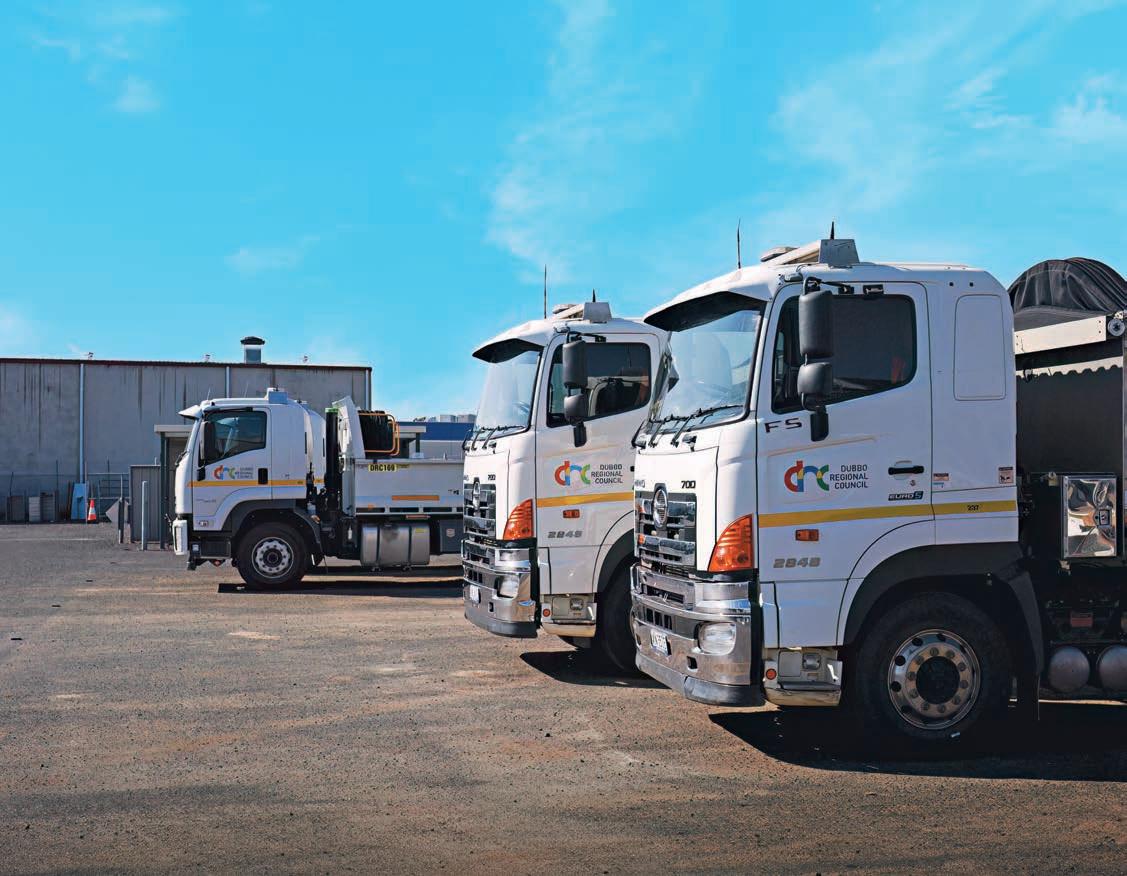
Dubbo Regional Council has utilised the latest in fleet management technology to increase the e ciency of its operations, improve worker safety and greatly reduce fleet running costs.
Maintaining the fleet of vehicles required to deliver the wide variety of public services that communities rely on is one of the largest expenses that local governments face.
Council fleets include a range of vehicle and equipment types, from lawn mowers to waste trucks. Managing and maintaining such a diverse set of assets can be complex and resource intensive.
Data-driven fleet monitoring systems are valuable tools that councils can employ to gain valuable insights to help them optimise the use and maintenance of their fleet assets.
Having the right data and analytics capabilities is crucial for managing fleet costs effectively. The operational demands of municipal fleets can vary significantly based on geographic and service delivery factors, which is why it is vital to have a tailor-made fleet monitoring set-up that meets
the data needs of a given fleet’s specific circumstances.
Dubbo Regional Council is a local government area in the Central West of New South Wales and runs a large fleet of vehicles and equipment, with which it delivers services to residents across an area of approximately 7,500km².
In an effort to bring down the costs of its fleet and work towards its sustainability targets, the council joined forces with Geotab – a globally recognised provider of vehicle management solutions – to deploy its telematics tools to improve day-to-day fuel efficiency.
What Council found however, was that Geotab’s telematics technology could also be used to create better maintenance plans for both the vehicles themselves and the roads they travel,
as well as improve the safety of its workers out on the job.
Geotab provided Council with a suite of its vehicle tracking tools, small devices that connect directly to a vehicle’s onboard computer. The devices provide fleet managers with a variety of data over time, such as the vehicle’s location, speed, fuel consumption, idling time, engine faults and even driving behaviour.
All of this data is analysed and cross referenced to create patterns of information that give managers a clear picture of their fleet operations.
Geotab Associate Vice President Government and Councils, Mark Bucknall, said that the thing about council operations is that there’s often a very diverse array of vehicles involved.
“Anything from lawn mowers through to refuse collection vehicles,” Mr Bucknall said.
“I think the real opportunity of telematics and Geotab systems is to be able to make sense of the varying needs of different departments.”
Geotab Senior Manager of Solutions Engineering for Asia Pacific, Chris Martin, explained that most vehicle fleets don’t typically have the wide diversity of asset types that councils do.
“Even within councils there’s differences, say from a metro council to a regional council,” Mr Martin said.
“There is no one size fits all, but there are some consistent patterns, and data is the key to that. Being able to measure it helps those managers understand, ‘what do these assets need to do, how have we been using them, and what are the things that we could be doing better to get more out of them’.”
Dubbo Council deployed 40 of Geotab’s telematics devices for a trial period, and very quickly found significant savings were possible by using the data to improve fuel and maintenance efficiency.
By monitoring vehicle location and engine data, Council was able to determine that workers were leaving their vehicles idling for significant amounts of time, which added
greatly to fuel, maintenance and depreciation costs.
“Dubbo Council was able to achieve a 28 per cent reduction in idling time,” Mr Bucknall said.
“The savings that they were able to get out of that was about $180,000 worth of fuel and maintenance costs.”
Monitoring driver behaviour can not only help to improve operational efficiency, but it can also be used to improve the safety of workers. Mr Martin explained that the Geotab devices can combine vehicle GPS data with readings from their own built-in instruments to determine how a vehicle is being driven.
“GPS lets you know where the vehicle is, the speed, the direction, that sort of thing. And then the accelerometer measures G forces in the vehicle. When a driver maybe hits on the brakes a little too heavy, or turns around a corner a little too fast, these are fairly obvious patterns that can lead to potential collisions,” Mr Martin said.
“By looking at patterns of what drivers are actually doing, we’re able to use AI to essentially determine a percentage likelihood of someone having a collision and, importantly, see if that changes over time.”
By analysing this information fleet managers can work with their drivers
to ensure that vehicles are being used safely and are operating correctly.
Another key innovation for Dubbo was the use of its pothole filling machines to help seamlessly plan road upgrades. The vehicles that fix the roads feed information back into Geotab’s database, which can then be used to map out the conditions of roads in the area.
Over the 12-month trial period, Council fixed 2,015 potholes. Using the data from these works, Council created a heat map that engineers used to decide what roads needed reshaping and what roads might need more work than others.
“Telematics doesn’t necessarily just have to be about the vehicle, it can be about other things too,” Mr Bucknall said.
“Having a vendor that has the ability to look into the specific needs of your organisation and be able to tailor solutions to suit them is really valuable.”
Dubbo Regional Council is one of the first to use Geotab’s devices in ways that go beyond monitoring vehiclerelated functions.
Council plans to roll out the devices to 280 of its vehicles in total. As it expands Geotab solutions to more vehicles, it is likely to uncover more savings and other fleet optimisation opportunities.
To learn more, visit geotab.com/au

Geotab devices saved Dubbo Council $180,000 worth of fuel and maintenance costs.

Reliable, sustainable and cost-e ective fleet vehicles are the key to councils providing vital services across their communities.
Council employees deliver a wide variety of local services. Often those services need an in-person touch, so dependable and economical transport is critical for staff in roles such as aged and disability care, child and youth support services, and maternal and healthcare services.
With budget pressures on the rise, councils need to source vehicles that meet their operational and sustainability needs without suffering excessive upfront and ongoing costs.
When it comes to fleet vehicles, sustainability and cost cutting benefits go hand in hand. By increasing the fuel efficiency of their fleets, councils can find significant savings alongside reduced carbon emissions.
Transitioning to an electric fleet has been proven to greatly reduce fuel consumption, resulting in positive budget and environmental outcomes. However, all-electric vehicles often don’t have the versatility or range to match the demands of council work.
GWM’s Haval H6 GT Plug-in Hybrid SUV is a sophisticated blend of traditional SUV design and
cutting-edge hybrid technology which delivers significant fuel efficiency and sustainability, helping councils meet their environmental and budgetary targets while delivering exceptional range and performance. Council staff can rely on the H6 as their primary travel and carpooling vehicle.
At its core, the H6 GT SUV’s plug-in hybrid system features a highperformance two-speed electric rear drive axle, increasing power and acceleration by enhancing wheel-end torque by up to 30 per cent.
The advanced dual-motor setup –incorporating both a generator and a drive motor – ensures seamless power delivery for a smooth, responsive driving experience. Intelligent in its design, the system not only enhances performance but also optimises hybrid efficiency.
Ideal for both urban commutes and rural adventures, the H6 GT boasts a class-leading EV-only range of 180km, complemented by an efficient 1.5-litre petrol engine, extending the total range to over 1,000km*. Say goodbye to range anxiety – this vehicle is built to take you further, making it a perfect choice
for demanding applications such as emergency management and disaster resilience planning.
Not only does the H6 GT’s fuel efficiency deliver significant cost savings alongside reduced emissions, but the upfront price of the hybrid vehicle won’t break the bank – a big factor for budget-restricted councils. Additionally, with stock already available in Australia, councils can start upgrading their fleets immediately, with no need for long wait times or delays.
The H6 GT also makes a great company car for employees looking to lease vehicles through their council. By utilising a novated lease, employees can have payments toward the vehicle and its running costs taken directly from their pay before tax, meaning they do not have to pay tax on that portion of their income throughout the year.
With its sophisticated hybrid design delivering exceptional performance, robust fuel efficiency and significant emissions reduction, the Haval H6 GT is an enticing option for councils eager to upgrade their fleet.
To learn more, visit gwmanz.com/au




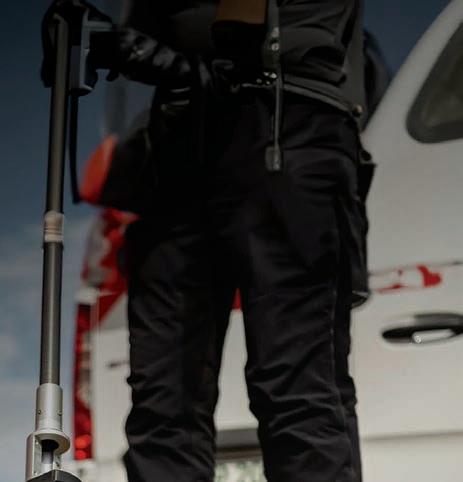
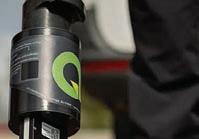

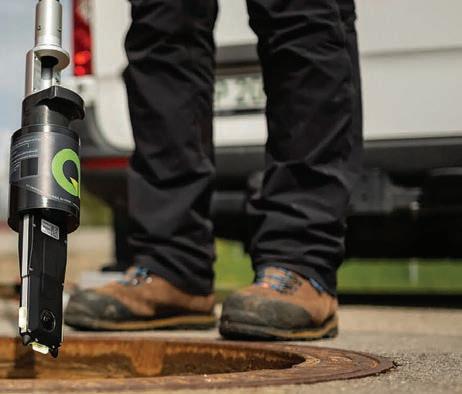


Automated Inspections: Perform rapid, accurate manhole inspections withhigh-definition 360-degree video.
Cloud Connectivity: Seamlessly transfer inspection data to the cloud via the WinCan WebFlex app.
Actionable Data in Minutes: Generate reports quicklywith features like AI-driven defect identification, 3D modelling, and laser range finding.




Efficiency Boost: Inspect more manholes in a single day, transforming hours of manual work into minutes
Portable and Wireless: Operates without cables, increasing operator mobility and ease of use.
Contact SECA today to explore how the Quickview 360 can save time and improve the precisionof your manhole inspections. Visitus online at seca.com. au or call 1800 028 584.
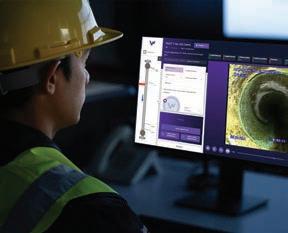





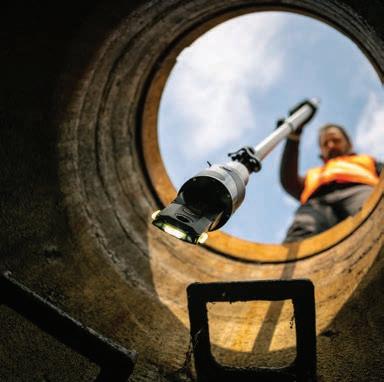
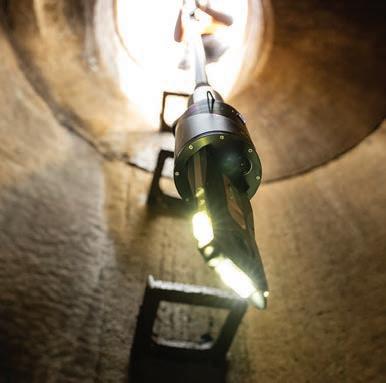

By Ellen van Holstein, Postdoctoral Fellow in the School of Global Urban and Social Studies, RMIT University
New research into council-run community centres has highlighted the challenges that come with these venues, as well as the important benefits they can provide in neighbourhoods around Australia.
Local governments in Australia increasingly manage community centres. This is a relatively new responsibility for local governments, as these spaces have traditionally been managed by grassroots community groups ba cked by state government funding.
The trend whereby councils are permanently stepping into the role of centre management is especially noticeable in Melbourne’s growth corridor, where local governments are building and managing neighbourhood centres to ensure that social infrastructure keeps up with population growth.
Councils that manage centres make a tangible difference in the lives of their constituents by
creating opportunities for people to meet others who in live in the area, by organising affordable exercise and craft classes, and by supporting access to emergency food hampers, and mental health and employment support.
Talking to council employees who manage two centres in Melbourne’s growth corridor, their team leaders and the people who use the centres, revealed that councils face some key challenges when managing centres.
To ensure that staff were able to speak freely about the pressures they encounter in their work, the research on which this article is based was conducted under conditions of anonymity, and for that reason, council and staff names are withheld.
The two centres run by two different councils on Melbourne’s fringe create important social opportunities for people in areas where community spaces are scarce. The two centres are especially valuable to elderly people and migrants, who applaud the affordability and inclusiveness of the group activities that are organised there.
For example, one centre organises yoga for seniors that is so popular that it now runs two fully bookedout classes per week. Yogis in the class find that yoga in commercial gyms and health studios tend to be too challenging for them. Even mainstream classes that initially seem

O ering yoga for older residents is one way community centres can have impact. Image: David L/peopleimages. com/adobe.stock.com
accessible often change to become too hard, too loud or too fast as soon as younger people join, they said.
Students in the class also said that at their local neighbourhood centre ‘the price is right’. Council offers this class for five dollars, and this means that people can afford to come weekly on their pensions.
This example shows that councils can make a real difference when it offers affordable activities that promote social connection, health, and wellbeing. Councils can play a role in service provision by filling gaps left by commercial providers, because councils can choose to offer programs in small groups that are tailored to specific needs in ways that commercial providers cannot.
The research uncovered many other examples of activities that were valuable for their affordability and their ability to meet niche needs and preferences related to cultural background, disability and age.
For example, the two centres host culturally specific seniors’ groups. They also both organise play groups and parenting groups that bring people with a shared experience of
cultural background, homeschooling or disability together to facilitate peer-topeer support.
In areas where meeting spaces are scarce, where people feel mortgage stress and where many residents are new to an area, these initiatives are invaluable for supporting health and wellbeing.
While centre participants were unanimously positive about centres managed by councils, staff identified some challenges. For example, they pointed out that council bureaucracy can create access barriers for centre users. Bureaucratic complexity limits the impact that councils can make if staff spend a considerable amount of time helping community members navigate paperwork.
One centre manager said that it was not uncommon for people to seek other meeting spaces when council’s paperwork was too complicated.
“Some people might have an idea that they want to get going as quickly as possible,” she said.
“Sometimes we lose out because they’ve gone somewhere else, for example to a community-managed centre. They will say ‘I’ve found an easier way where not so many questions were asked’, or ‘I didn’t need to submit or do this or that.’”
Councils have a responsibility to conduct their business in an accountable way and some paperwork
likely to affect people who are already at greater risk of experiencing isolation. In order to run an accessible centre and to protect their reputation with residents, councils need to shield centre users from excessive administrative demands.
The complexity of how councils operate can take up much of managers’ time. At both councils, centre managers described their job as ‘admin heavy’.
Their administrative tasks include ensuring that teachers and contractors are properly onboarded and covered by insurance, and filling out program logic tables for each of the activities at their centre each semester.
When asked whether she ever works unpaid overtime, one manager said, “Definitely, especially when program logics are due. For my centre, we’ve got 25 programs and you’ve only got like a week and a bit to pull them all together. So I’ll always work overtime just to get them all done.”
Other managers added that the continuous roster of activities at a centre does not allow them to recover these hours by taking time in lieu. In addition to creating pressure on staff, an excess of administrative tasks takes staff away from important tasks such as attending to centre visitors and the wide range of sometimes pressing and distressing issues they present with. Councils that task their centre managers with administration that is redundant or that could be centralised inadvertently reduce the impact a centre can have on the ground.


other council employees.
For example, one manager described council pushback against offering a room at a reduced rate to someone who runs a cooking class for autistic children.
“They’re pushing back on these kinds of agreements because they see it as a revenue thing. They’ll say things like, ‘Well, she’s charging for the class so she can afford to pay full price for the space.’ Whereas from a community point of view, we should be looking at the service what she’s offering the community.”
Managers also regretted that their colleagues in other departments do not consult them.
“They’ve built this centre with this massive reception desk. I’m not going to sit there because I can’t do my work if I sit there. Now if you’re approaching the centre for the first time, you walk up and then you’re standing at a reception desk and there’s no one there to actually help you.”
These examples show that it is important for councils to engage with centre managers because a lack of understanding of what happens in a centre can hamper council’s ability to
ensure their investment in a centre leads to optimal results.
Lastly, it can be difficult for councils to act with confidence when they manage a space that is intended to be for members of the community.
One council made a blanket decision not to organise any activities themselves lest they stifle community leadership.
A team leader said, “When I first started, we used to run a lot of activities, whether that’d be a playgroup or some sort of community celebration, and over time, we’d work more and more with community. And now, if community are not starting that work, we’re not doing it.”
A hands-off approach like this limits the practical outcomes that a council can achieve, because reacting to preconceived community initiatives does not allow a centre to bring new people into a centre.
Centre management presents tremendous opportunity for a council to engage with a large variety of residents, and when councils do this with clear objectives, they can generate impacts that range from creating rapport with segments of the population that are otherwise hard to reach, creating new community leadership skills, and effecting
Councils that manage centres make a di erence in the lives of their constituents. Image: DC Studio/adobe.stock.com
economic, social and health related changes in people’s lives.
Councils are doing positive work by taking on centre management, because centres create unique opportunities for people to be actively involved in exercise, work, education and leisure in their neighbourhood.
By managing centres, councils can curate accessible and affordable social opportunities in their local government area, especially when it focuses on programming activities that are unlikely to be facilitated by commercial parties.
Councils that consider taking on centre management can maximise impact by shielding managers and centre users from administrative burdens and by including managers in strategic decisions.
They can also maximise impact by continuously seeking engagement with new centre participants, as new visitors stand to gain most from becoming engaged in centre programs.
For more information, and to read the report in full, scan the QR code.
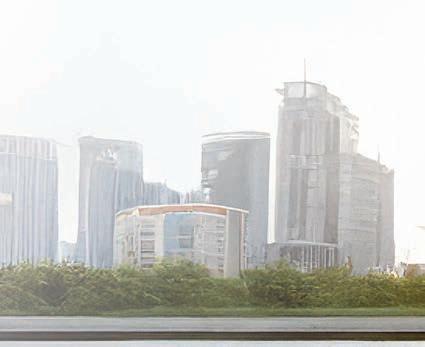


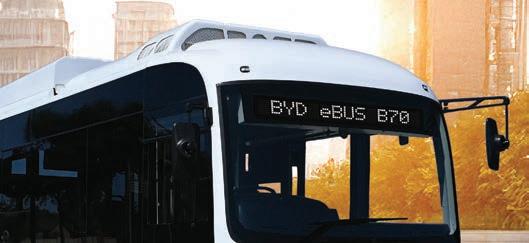





















The BYD B70 is engineered for the unique demands of city transportation, o ering a quiet, zero-emission drive with dependable 138.3 kWh battery performance.
With a low-floor design and up to 18-passenger capacity, it’s built for e iciency, comfort, and accessibility. Experience the future of mobility today.

BYD Commercial Vehicles are available in Australia, sold and distributed directly by BYD.
BYD Commercial Vehicles has streamlined service and support to keep your fleet running with minimal downtime.
Our industry-leading electric buses and trucks are backed by BYD’s global expertise and innovation.
Genuine parts & service – Direct access to genuine BYD components and expert technicians.
Cutting-edge technology – The latest advancements in sustainable mobility, straight from the manufacturer.
Stay tuned—our highly anticipated BYD Truck range is launching soon in Australia
For Bus Sales, contact Steven steven.glenny@byd.com or0405 361 958
For Truck Sales, contact Jon jon.tozer@byd.com or0407 048 097
For Spare Parts, contact Kevin kevin.ng@byd.com or 0481 218 646
www.byd-australia.com

Among the wide variety of services and benefits that councils provide, creating high quality public spaces where communities can connect and socialise is one that is commonly overlooked.
Australian councils deliver public projects that improve liveability, foster connection and provide social spaces for communities – all while managing tight budgets and sustainability targets.
For local government, choosing the right supplier is a must. Timely turnarounds, low costs and responsibly sourced sustainable products are vital to ensure projects are completed onbudget and on-schedule while delivering best-possible outcomes for both council and community.
BAB Aluminium is an Australian manufacturer and supplier of aluminium seating products, with over 40 years of experience providing to the Australian market and beyond.
BAB provides high-quality aluminium seating and setting solutions to a wide range of customers, including schools, councils, clubs and government departments. A longstanding partnership with Capral Aluminium, coupled with extensive experience, ensures BAB can meet the needs of
businesses from small operations to multi-national organisations.
BAB Aluminium CEO, Brian Blowes, said that he is fiercely proud of the work BAB does to provide customers with high-quality products.
“In 2023, we went through 140 tonnes of aluminium. That’s a lot of aluminium. That goes out as a grandstand, as a seat, as a buddy bench, as a table. We average two to
BAB provides high-quality aluminium seating and setting solutions. Images: BAB Aluminium

three tonnes of seats every month,” Mr Blowes said.
“We go to a lot of trouble to make the best products for our customers.”
Mr Blowes explained that BAB is the parent company that delivers the majority of its projects, but under that umbrella are the more targeted providers, Buddy Bench and Grandstands Australia.
“They’re all doing their own job. BAB produces tables, seats and other products. Buddy Bench is exactly what it says, Grandstands is exactly what it says. It’s just a really clear message to the market saying, ‘this is what we do’.
“Our client base is everyone. We have people buy them for their backyards, or the local council, the local school, state government, federal government.”
Mr Blowes said that BAB’s reach even extends internationally.
“We’ve actually got seats on a boat on the Thames River in London, and
the US Embassy in Singapore have got our tables and chairs on their grounds. Our reach is absolutely national, but also international.”
BAB’s tables, which are offered as a range from T1 to T5, are designed with subtle variations to meet the aesthetic and functional needs of parks, schools and outdoor spaces.
Grandstands Australia offers larger seating solutions that range from compact, portable models, to large, modular setups which can hold up to 500 people. These grandstands have become staples in sports venues and community events across Australia.
“There is no one else in the market that’s got something that will sit 500 people.”
The Buddy Bench represents the company’s most meaningful offering. These vibrant and colourful seats are intended to combat bullying and loneliness in schools. By providing a welcoming space for students, these benches help foster connection and inclusivity.
BAB produces its products from aluminium supplied by Capral Aluminium, in a partnership that has lasted more than 40 years.
“Capral’s been my supplier since 1980, since back in the old Alcan days. It’s family,” Mr Blowes said.
My Blowes explained that the manufacture of BAB’s product range is
streamlined by producing them using a limited number of aluminium feedstocks.
“I’ve designed our products around about five feedstocks, to keep it simple. We’ve got a couple of flat bars, tube, seating section, a couple of different boxes and some angles, and we basically make almost all our range out of that.
“Of the 130-150 tonnes of aluminium that we use every year, about three tonnes of it becomes off-cut. It gets recycled and turned back into an aluminium coke can or beer can or whatever.
“On top of that we basically reuse everything else here, all the timber and the plastic, we reuse all of that in our packaging back out to our customers.”
In additional to its sustainable practices, BAB utilises only Capral’s LocAL Super Green Low Carbon Aluminium, which is produced using hydroelectricity during the electrolysis process, achieving significantly lower CO₂ emissions per kilo of Aluminium produced compared to traditional energy sources.
“Mary-Anne from Capral approached me with the idea of LocAL Super Green and left it with me for a week, dropped back in and I said ‘look, we’d be crazy if we didn’t do this, it’s a no-brainer’.
“Given that we already recycle everything we can here, it just made sense – from a corporate responsibility perspective if nothing else – to save 75 per cent carbon. I don’t think that’s a very hard equation to get your head around.”
To learn more, visit babaluminium.com.au
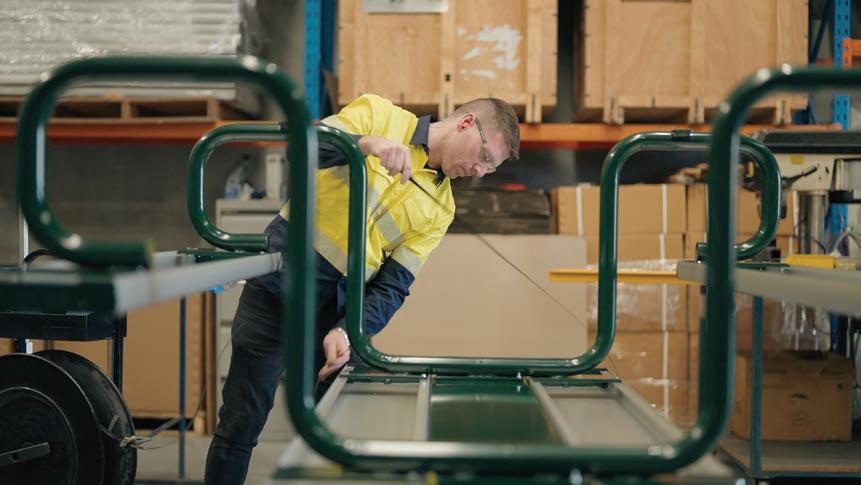
Councils have a responsibility to create communities where all people are welcome, including those with disabilities and high support needs.
Changing Places is an initiative originally launched in the UK in 2006. The program seeks to create public toilet facilities designed for people with high support needs that are not met by traditional accessible toilets. Without access to a suitable facility, many people and their families may have to limit their outings in the community.
A Changing Places facility allows people to participate in all elements of community life, without having to limit their time out due to concerns about being able to access a suitable toilet.
As part of efforts to improve accessibility in its region, Maroondah City Council opened Australia’s first Changing Place in 2014.
Changing Places facilities include:
• Height-adjustable adult-sized change tables
•Constant-charging ceiling track hoist systems
•Centrally located peninsula toilets
• Additional circulation space, more than standard accessible toilets, allowing for one or two carers to assist the person to toilet and dress.
•Automatic doors with a clear opening of 950mm at minimum
•Privacy screens
Since that first facility opened at Ringwood Lake in 2014, more than 300 Changing Places have been created across Australia.
The Federal Government has supported the delivery of these Changing Places by providing funding to local governments who do not already have a comparable facility.
The funding is being implemented in four tranches, in the 2022-2023, 2023-2024, 2024-2025 and 2025-2026
financial years.
As of 1 February 2024, the government has increased the funding on offer and
all local governments are eligible to receive funding for a Changing Places facility, regardless of existing facilities.
Where previously the Federal Government had agreed to contribute one third of the total build cost for each facility, it has now committed to provide up to half of the total cost. The Federal Department of Social Services is responsible for the implementation, which is undertaken in partnership with state and territory governments.
As part of this funding agreement, all Changing Places facilities must be accredited by a Changing Places Assessor. Additionally, funding recipients must ensure that once the Changing Places facility is accredited, it is listed on the Changing Places website and the National Public Toilet Map.
Accreditation ensures that Changing Places are designed and constructed
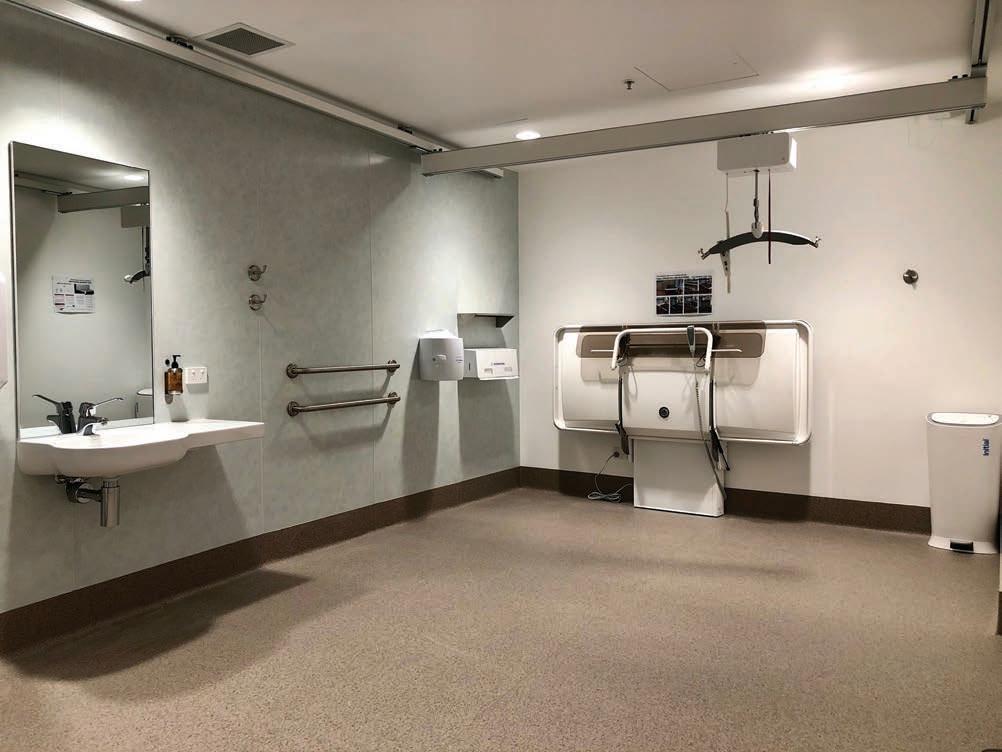
in accordance with the Changing Places Guidelines, giving users confidence that the design and construction is fit for purpose.
Once a Changing Places Assessor has assessed a facility and is satisfied it meets the requirements of the Changing Places Design Specification 2020, the council is then issued a Statement of Compliance. A copy of the Statement of Compliance must then be provided to the Department of Social Services.
To guarantee a Changing Places accreditation – thereby gaining access to valuable funding, while providing a high-quality facility for the community – local governments can employ a specialised Accessibility Consultant.
Architecture & Access has been a provider of specialist access advice since 1998. It is the largest access consultancy business in Australia, with a presence in Melbourne and Brisbane, providing services across the country. Its in-house Changing Places Assessors can review the documentation for a facility during the design phase to ensure
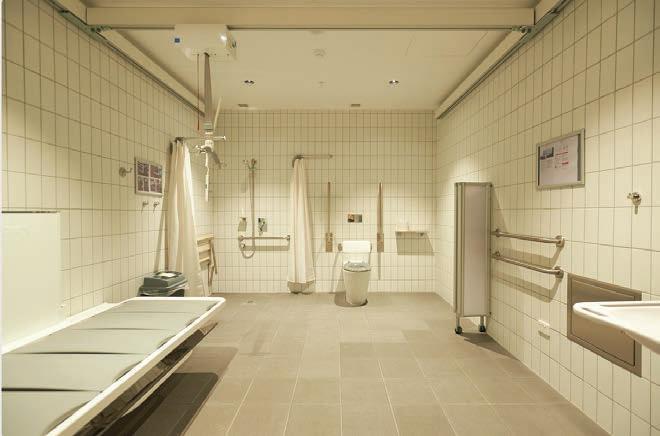
Changing
the completed facility can be registered as an accredited Changing Place.
Design reviews of a facility can be completed at the schematic design and construction documentation stage of the project.
At the completion of construction, Architecture & Access will then conduct a site inspection to review the ‘as-built’ structure for final accreditation with Changing Places.
If the facility passes inspection, Architecture & Access will then issue the council with a Certificate of Compliance, which is suitable to submit to register the facility with Changing Places and achieve compliance with the Department of Social Services’ funding requirements.
To learn more, visit architectureandaccess.com.au















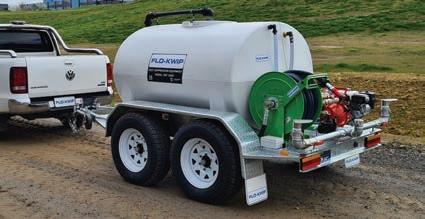

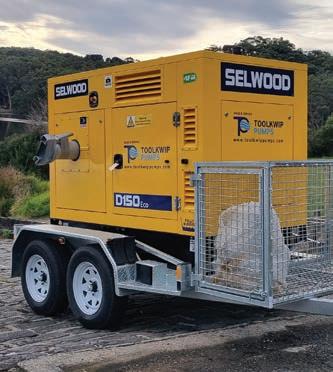
Community events bring locals together – but how can councils ensure their spaces are comfortable and inviting for everyone?
As communities around Australia continue to grow, community events and activities become increasingly important for locals to stay connected.
Councils play an essential role in building and maintaining the spaces that enable this connection, such as parks and ovals, ensuring they are wellequipped to meet the diverse needs of the community.
One of the most crucial – yet perhaps overlooked – elements in creating functional and inviting spaces is comfortable seating. Grandstand seating is a popular choice for outdoor venues because of the excellent use of space, versatility, comfort and practicality.

The tiered configuration of grandstand seating allows for a higher seating capacity and an obstructed view for everyone, regardless of where they sit. This allows more people to attend and enhances the experience of guests and spectators.
More than just a place to sit, grandstand seating creates an inviting space for members of the community to come together, engage and support local events and each other.
Felton Industries is a leading designer, manufacturer and supplier of quality Australian made outdoor furniture, with more than 20 years’ experience in supplying premium seating solutions for all educational, community, sporting and commercial environments.
Councils around Australia trust Felton to provide grandstand seating to transform their outdoor spaces and provide accessible, comfortable seating for their communities.
For example, Parramatta City Council used Felton to upgrade Garside Park and create an inviting outdoor space with ample seating. Felton worked collaboratively with the Council and its contractors to create a customised
product that effortlessly integrated into the park’s existing layout, enhancing the park’s functionality and comfort.
Bega Valley Shire Council also worked with Felton, calling on the company for help replacing old grandstand seating.
After consulting with the council about its specific requirements, Felton custom designed a custom range of grandstands to meet the council and community’s needs. From design, manufacture, on-site assembly and installation, Felton delivered the project in just eight weeks – providing a stylish and comfortable vantage point for the community to support its local teams.
Felton is a Local Government Procurement Approved Contractor in New South Wales, Western Australia, Queensland, South Australia, Tasmania and the Northern Territory, meaning councils in these states are not required to conduct formal tenders on a projectby-project basis.
In February 2025, Felton launched its new comfort grandstand range, offering enhanced comfort, flexibility and functionality – all while maintaining the company’s signature quality, durability and sustainability.
The range builds on the Felton’s existing single-plank grandstands but offers twice as much space for each seat,
allowing patrons to sit comfortably and navigate the stands without disturbing other spectators.
Felton Industries Product Marketing Manager, Simon Clayton, said the company is constantly evolving to meet customer needs.
“Attending sporting events and community gatherings should be enjoyable, and our new range is designed for that very reason.
“The wider seating, increased legroom, and improved safety features reflect our commitment to enhancing the lives of our customers and their communities,” he said.
Available in various sizes and tier configurations, Felton’s comfort grandstand range is customisable to the specific needs of each venue.
It is made from premium aluminium, making it a lightweight, durable and 100 per cent recyclable outdoor seating solution.
“The comfort grandstand range represents a major step forward in comfort, accessibility, and sustainability,” Mr Clayton said.
“We’re so excited to bring this product to market and look forward to seeing how it transforms outdoor experiences for councils across Australia.”
To learn more, visit felton.net.au
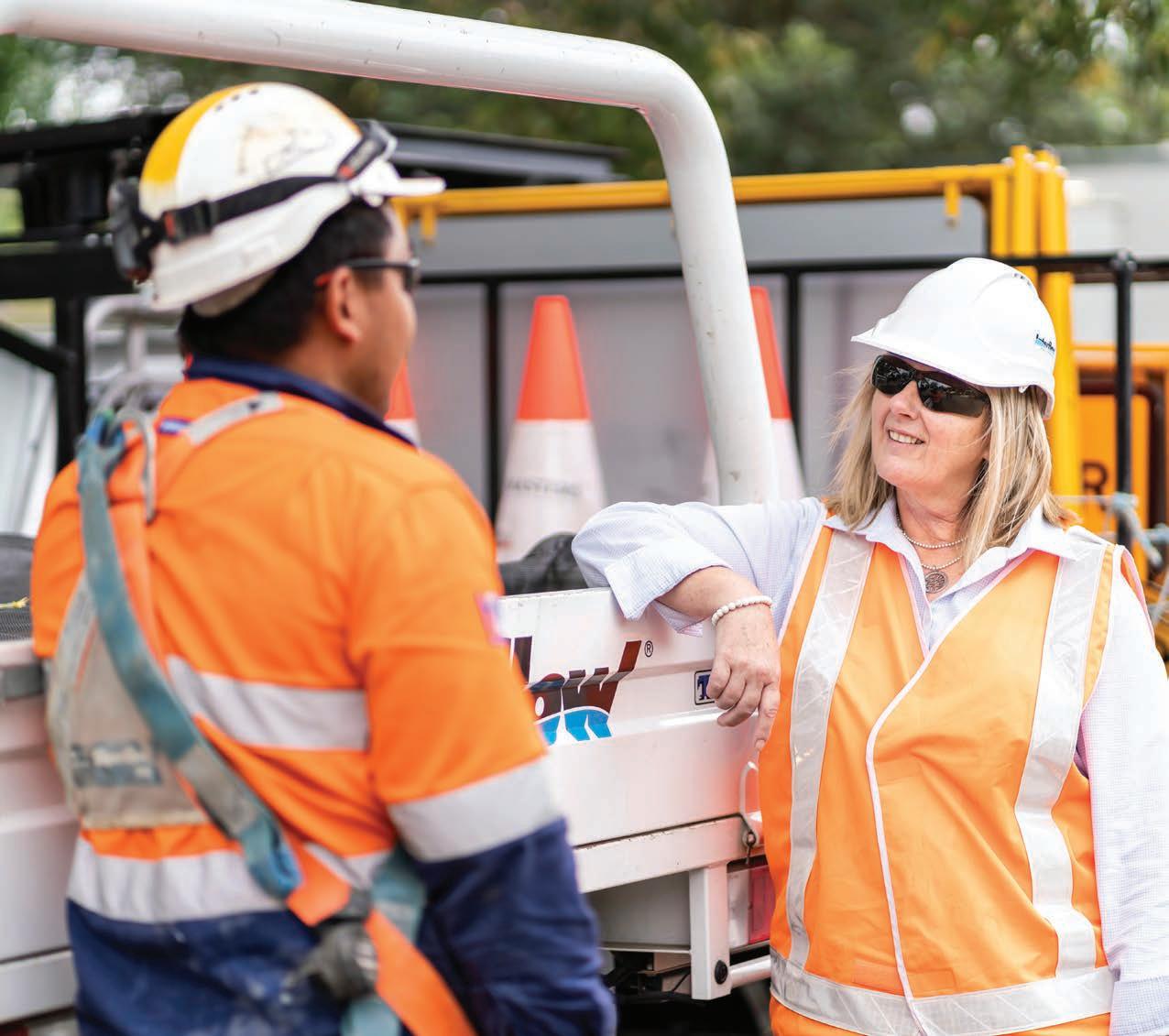







We’re Creating the Future of Water for our people and communities, for generations to come
To meet the critical targets of Australia’s net zero goals, many local governments are electrifying their street cleaning fleet assets and finding the benefits are more than just emissions reduction.
More councils are investing in the sustainability of their fleets, meeting emissions reduction targets and delivering better, more environmentally friendly services for their residents.
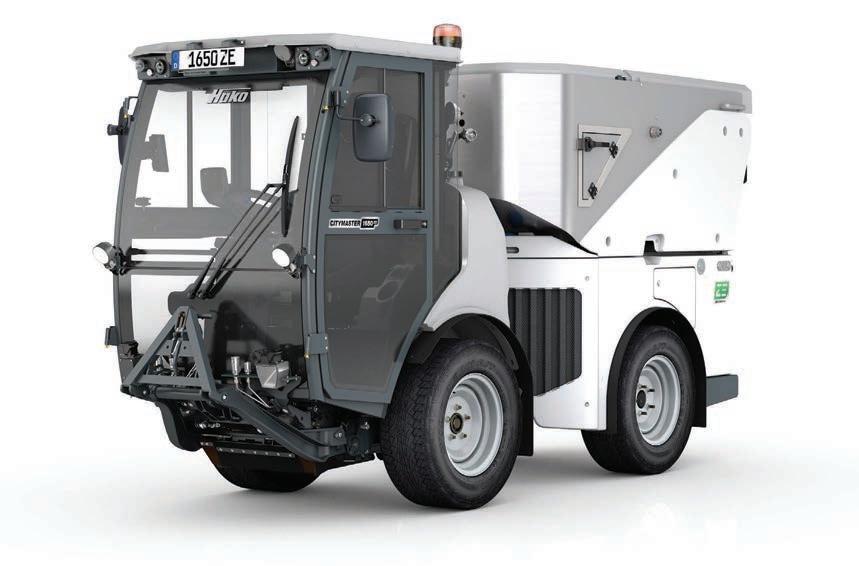
emission and low noise.
Delivering clean, safe and attractive streets is an important service that councils provide. Traditionally however, conventional diesel-engine street sweeping machines have been a major source of complaints from community members, due to their exhaust emissions and disruptive noise.
Councils that procure the latest in electric street sweeping technology will not only be well on the way to meeting their climate goals but will also find significant positive outcomes for their communities and services.
The Citymaster 1650 ZE is the first all-electric city sweeper in the 3.5t class made by Hako.
It combines economic efficiency with sophisticated sustainability technology to deliver services with no diesel costs or emissions, minimal noise and a suite of interchangeable tools and attachments to meet the needs of any street cleaning situation.

Ergonomic and safe user design ensures the safety and comfort of operators, while camera systems ensure a good all-round view and offer additional assistance when reversing or turning, minimising costly collisions or accidents.
The Citymaster’s electric drive delivers just as much power as a traditional diesel-driven sweeper but with none of the carbon dioxide emissions.
Providing up to nine hours of operation on a single battery charge, this machine is equipped with more than enough range for the long days of council work.
With a top speed of 40km/h, the Citymaster can quickly get to the next job site or charging station, allowing fast, easy and safe charging of the battery.
Carbon emissions aren’t the only kind of pollution that the Citymaster helps to mitigate. Overly noisy street sweepers can be a significant source of disruption for local residents, but thanks to its electrified and community-conscious design, the Citymaster offers a much quieter solution.
Not only does the electric drive minimise engine sound but the specially designed ‘silent brooms’ also contribute to ensuring significantly reduced noise pollution both in and outside the cabin, providing a more comfortable experience for operators and less disruptions for communities.
In addition to its two to three dry rotating brooms for standard
sweeping, the Citymaster has access to a wide range of different tools and attachments that can be used for a variety of applications.
Possible attachments and applications include:
Dry cleaning
•Dirt sweeping
•Leaf blowing
Wet cleaning
• Scrubbing
• Sluicing
• High pressure washing
•Watering arm Transport
• Tipper
•Lattice box
• Trailer
Thanks to its multifunctionality, the Citymaster can carry out the work of a whole team of machines.
Additionally, the Citymaster offers significantly improved driving and operating comfort compared to similar machines, thanks to the ergonomic cabin design and internal air conditioning system.
All functions can be controlled at just the push of a button via Hako’s one-button operating system integrated in the armrest, and the large display provides at-a-glance information on all relevant operating data.
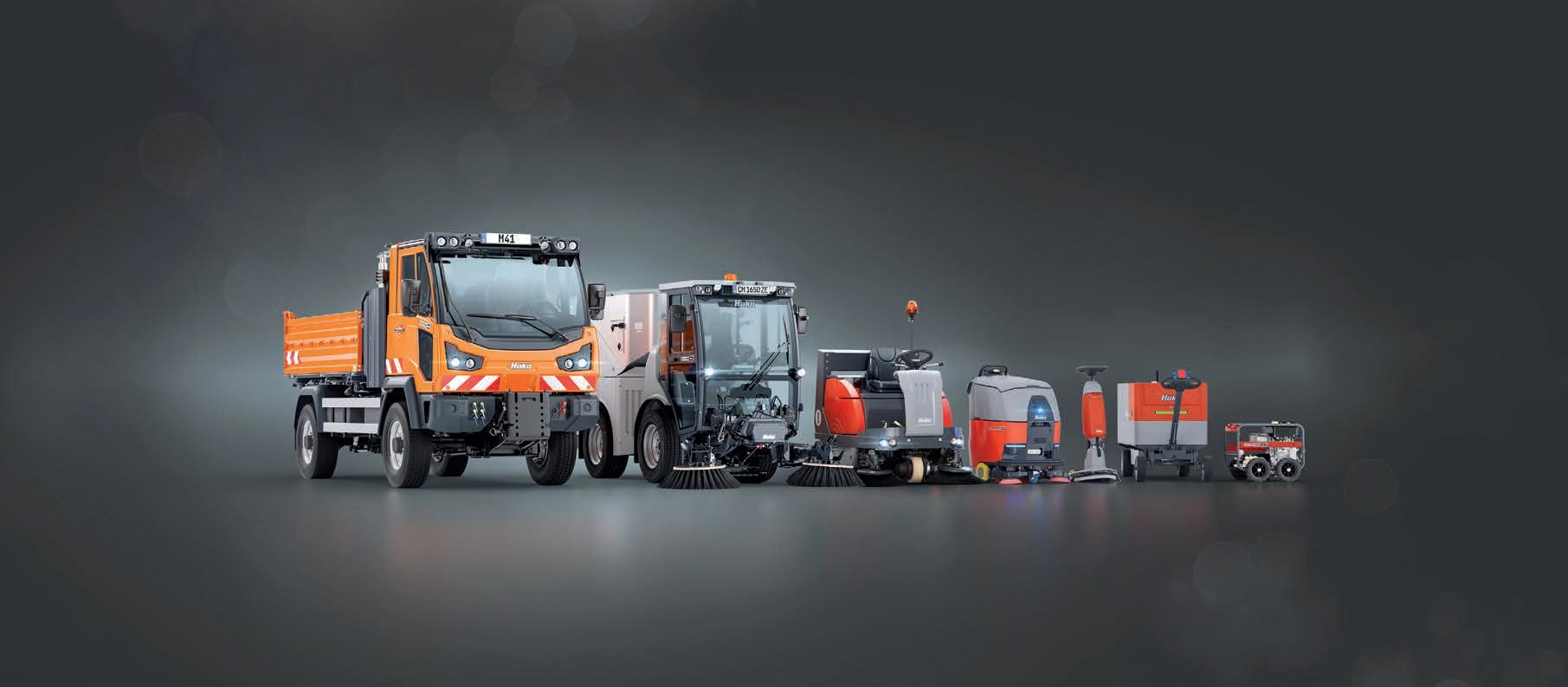
The Citymaster 1650 ZE is an intelligently designed machine capable of filling the needs of any street cleaning operation, all while delivering great sustainability outcomes and minimal noise pollution.
To learn more, visit hakoaustralia.com.au



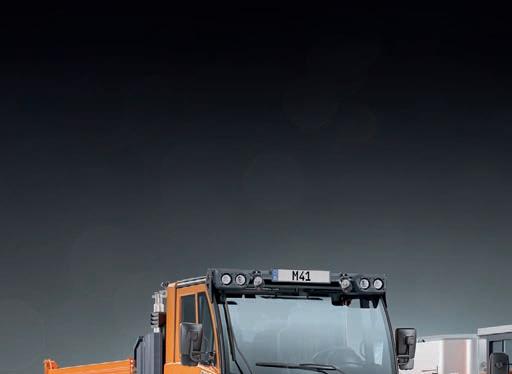


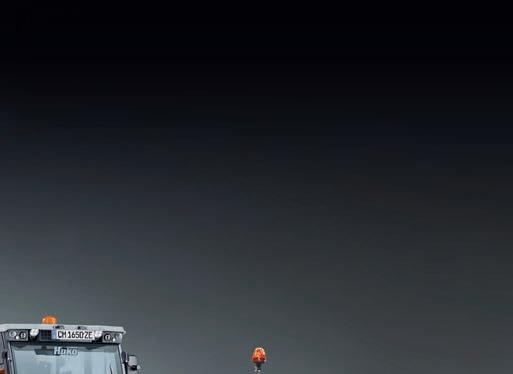

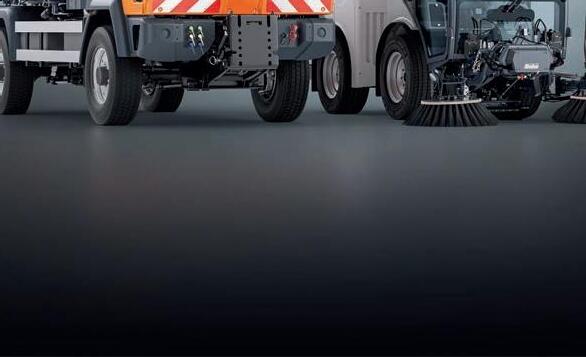
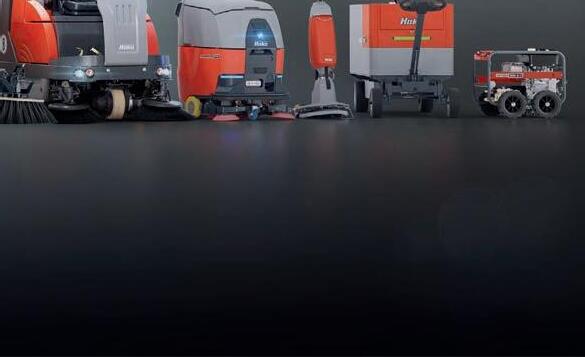
Maintaining communities inevitably leads to construction works, and integrating sustainable equipment and technologies has many benefits for residents.
Australia’s councils all undertake significant capital works programs every year. In 2022-23, Victorian councils alone spent approximately $4.15 billion on capital works, and these figures will only continue to rise nationwide as populations grow.
The scale of works to be undertaken is huge, and councils need to look to construction solutions that minimise the impact on communities and manage costs in a responsible manner.
One of the first steps councils can take to manage costs and deliver capital projects more effectively is by looking closely at the construction equipment they use.

Volvo Construction Equipment, through its distribution partner CJD Equipment, has a range of options to suit every council around Australia.
Volvo Construction Equipment’s mini excavator technology is part of a remarkable transformation in construction equipment. The ECR18 and ECR25 electric excavators match their diesel counterparts’ digging power while helping the environment, working actively for up to four hours per charge and excelling in urban construction projects.
The ECR25 electric dominates the electric construction equipment market, working efficiently even in tough conditions. The ECR18 electric meanwhile uses just 5.6 kWh of energy to dig a 20-metre trench.
These excavators also let crews work in noise-sensitive areas without expensive fume extraction systems. Their charging speed impresses toothey reach 80 per cent capacity in just one hour, which keeps downtime low.
Electric mini excavators mark a fundamental change in construction equipment design, bringing together groundbreaking engineering and ecofriendly solutions.
The machines use lithium-ion batteries and dedicated electric motors instead of conventional diesel engines, and as a result, there’s a wider range of jobs that excavators can take on.
Their smaller size means they can manoeuvre into once hard-to-reach locations; and because operating them produces significantly less noise than diesel machines, construction teams can work at night in populated areas.
This helps reduce traffic congestion during busy hours, and the lower noise level also means that workers can communicate better during a job, guiding operators while staying at safe distances.
In areas with strict environmental rules, particularly around low emissions, the machines can run without any limits. Around the world, the combination of reduced noise and lower emissions has made the ECR18 and ECR25 electric excavators a popular choice where noise and emission controls are strict.
The fact that the mini excavators run without fume extraction systems means they can be used efficiently and effectively in enclosed spaces, totally changing the excavation market.
Team members operating these machines also breathe cleaner air and feel less tired after their shifts, an important benefit for council employees.
The excavators can achieve this while packing the same power as diesel ones, so there’s no drop in performance during tough demolition jobs.
Volvo’s ECR18 and ECR25 electric mini excavators showcase exceptional performance metrics and impressive cost benefits. These machines match their diesel counterparts in power and cut energy costs by up to 48 per cent; and they work well in noisesensitive areas with zero emissions, making them perfect for urban construction projects.
These excavators take construction operations into the future. Their smart technology and telematics fit perfectly with smart city needs, a consideration for many councils.
The ECR18 and ECR25 electric models prove that eco-friendly construction equipment still delivers top performance and productivity. Their success in urban settings, plus economic and environmental advantages, makes them ideal solutions for modern construction projects.
Construction professionals can test drive one of the mini excavators at their local CJD Equipment Branch.
To learn more, visit cjd.com.au

Civil Site Design® is an easy-to-use civil design solution that adds road reconstruction, road design, site grading, stormwater, pipe and sewer design capability to your CAD platform. Using familiar string and template design, Civil Site Design includes a complete set of civil tools to supercharge your design, in one low-cost version. Design and drafting are cleverly integrated to reduce wasted time and improve production outcomes.
Developed in Australia, Civil Site Design is already used by more than 120 councils.
To find out how Civil Site Design can leverage your CAD investment and save time on your next civil design project, use the QR code for a quick video overview.
Request your free 30-day trial or software demo now.




A new initiative from Tasman Council centres around celebrating the joys of regional living.
The friendly and easily accessible Tasman region, located on Tasmania’s southeast coast, starts less than an hour from Hobart and spans both the Forestier Peninsula and Turrakana/Tasman Peninsula. This perfect region is flanked by coastal cliffs, idyllic beaches, native tree forests and countryside of undulating hills. It attracts those looking for a sea change and a quieter lifestyle.
Originally home to the Pydarerme people, followed by the many convicts who went on to forge our nation, the Tasman region evolved to be known as a natural escape and a quality place to live, work and play without the hustle and bustle, traffic or pollution of urban living.
Tasman Council hosted its inaugural THINK TASMAN event in Hobart in October 2024, bringing together an impressive audience of local leaders, parliamentarians, business professionals, developers, investors and producers. The event shone a spotlight
on the Tasman region’s finest products, entrepreneurial spirit and vision for the future with an engaging program that blended thought-provoking insights and an unforgettable culinary journey.
Tasman Mayor, Cr Rod Macdonald, highlighted the council’s focus on supporting local businesses.
“The evening substantiated the Tasman Council’s commitment to supporting the region’s local industries and fostering future investments, with an outstanding program that featured guest speakers and an unforgettable culinary experience,” said Mayor Macdonald.
The THINK TASMAN event was designed to strengthen ties between the region’s business community, stakeholders and potential investors while showcasing what makes Tasman unique. Todd Babiak, CEO of Brand Tasmania, served as the evening’s charismatic emcee,
setting a vibrant and welcoming tone. His ability to weave the evening’s themes of community, innovation and opportunity resonated deeply with attendees.
Among the event’s key moments was a presentation by Andrew Crane from Tasmania’s Office of the Coordinator General. Focusing on economic growth, the presentation underscored the importance of highlighting Tasmania’s point of difference and the collaboration between local industries and external partners. It was a powerful reminder of how interconnected efforts can propel a regional area to new heights, solidifying the Tasman’s reputation as a hub of quality production and innovation.
This event celebrated the Tasman region’s extraordinary culinary offerings. Executive Chef, Simon Pockran, crafted an exquisite menu that perfectly captured the region’s essence featuring the finest local ingredients. Each course was a testament to the Tasman’s
producer’s dedication to sustainable and high-quality production.
“Showcasing Tasman’s best, Simon crafted dishes featuring local seafood, chicken, beef, lamb, honey, mustard, pears, vegetables and chocolate, each artfully paired with an impressive selection of local ciders, gin, wines and whisky. These carefully curated elements highlighted Tasman’s unique flavours, paying homage to the region’s commitment to sustainable, quality production”, Mayor Macdonald said.
“The food tonight truly reflects the heart of Tasman,” said one attendee. “Every bite and sip told a story of the region’s heritage and its commitment to excellence.”
The event’s successes were also attributed to the generosity of local producers and to the Henry Jones Art Hotel in Hobart who professionally supported the evening. Each participating business featured in the printed menu booklets, telling the story of the people behind the produce. This booklet is available on the Tasman Council website.
“The success of Think Tasman signals an exciting future for the region and it reinforces the Council’s focus to foster collaboration among stakeholders in driving regional growth,” said Mayor Macdonald. “Our aim is for people to THINK TASMAN as the perfect place to live, work, play and do business.”
The Mayor’s words reflected the event’s overarching mission: to inspire attendees to see the Tasman region
as a vibrant, thriving community full of potential.
The Tasman region has a seasonal population of about 2,700 full-time residents and swells to over 9,000 in summer. The region relies heavily on seasonal tourism, aquaculture and agriculture. Tasman Council has adopted a doughnut economy approach, which is pivotal in fostering long-term economic resilience.
The doughnut economy focuses on balancing essential human needs with the planet’s ecological limits and aligns well with the region’s strengths – local produce, sustainable practices and community-centred commerce.
Supporting local businesses helps ensure that money stays within the community, benefiting small-scale farmers, artisans, and service providers while promoting environmental sustainability. With the ebb and flow of tourism and seasonal industries, a circular economic model creates a more stable foundation, where resources are reused and waste minimised.
This approach can reduce dependency on external markets and foster a more self-sufficient, eco-conscious economy that thrives on local ingenuity and resourcefulness, ensuring the region’s future remains bright for both residents and visitors alike.
Attendees left the event with a renewed appreciation for the Tasman region’s rich resources, remarkable producers and forward-thinking leadership. The evening’s blend of networking, education and culinary artistry created an unforgettable
experience, further cementing the region’s reputation as a premium source of quality products and innovation.
As the inaugural THINK TASMAN dinner drew to a close, the sentiment was clear: the Tasman region is poised for greatness. By championing its local industries and embracing collaboration, the region is not just showcasing its potential – it’s realising it.
A main feature of the evening were presentations by local producers and business people, accompanied by two THINK TASMAN videos created by local business Tunnel Bay Productions. One of the videos shone an authentic spotlight on local businesses Bangor Vineyard Shed, Tasman Honey, Cubed Espresso, Port Arthur Lavender Farm, Osborne Aviation, OE Hansen orchard and Saltwater River Wines and why they choose to operate in the region.
The second video, ‘Here We Are – Think Tasman – Dusty Rusty’, celebrates the beautiful landscapes and local people who contribute to the vibrant community, capturing the true essence of the place. This second video also features an original soundtrack by local artist Dusty Rusty, further highlighting some of the talent in the region. Both videos are available for viewing on the Tasman Council’s website.
For those who attended, THINK TASMAN was more than just an event; it was a proactive, valuable, council-led approach to creating a call to action to invest in, support and celebrate the incredible opportunities that the Tasman region has to offer.
To learn more, visit tasman.tas.gov.au/think-tasman
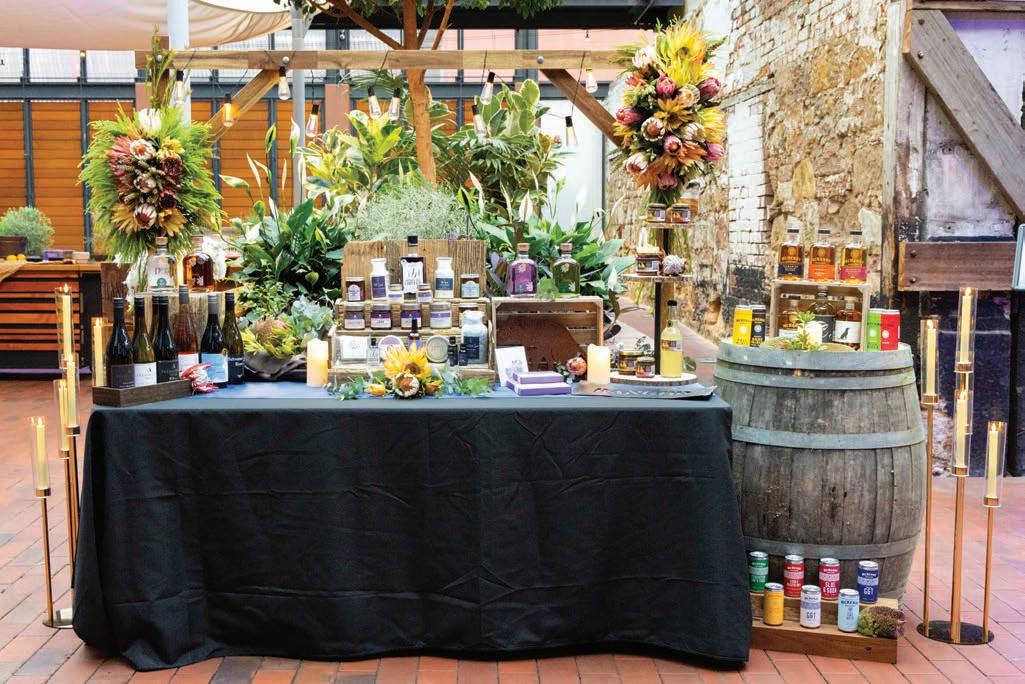
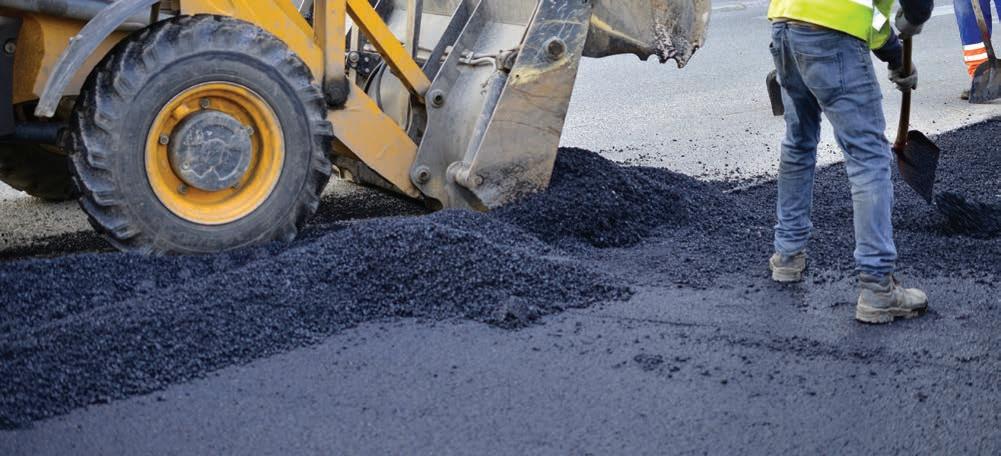
Converge will showcase the full construction lifecycle in Australia. Image: bellakadife/stock.adobe.com
In September 2025, all facets of the municipal construction sector will gather at the Melbourne Convention and Exhibition Centre.
Converge is the only Australianowned major event showcasing the latest tools and technology in the municipal works, civil and commercial construction space.
The focus for the event is to showcase the full construction lifecycle in Australia, with presentations from federal, state and local governments on the developments, projects and initiatives that are required to fulfil the needs of our growing communities.
From council developments, such as the delivery of affordable housing, local roads and community leisure centres, all the way through to the major projects driving our cities forward, including new metro rail tunnels, arterial roads and new tunnels, it’s all on the agenda for the Converge conference program.
Supporting the speaker sessions is a full-scale exhibition, where attendees will be able to enjoy a mixture of live demonstrations and product and equipment showcases. The show will bring together a range of disciplines so that practitioners can learn from each other, and discover the solutions they need to build and maintain the Australia of tomorrow.
The dedicated municipal works zone will function as a niche area for councils and asset managers to see the latest tools available in municipal works. From horticulture equipment through
to road maintenance, and larger scale trade equipment, the area will act as a one-stop-shop for council fleet managers and sub-contractors to see the latest tools on offer, with a special focus on zero emission technology.
Co-located with Converge are two additional construction industry events: No-Dig Down Under and the Carpentry Expo.
No-Dig Down Under is the southern hemisphere’s only large-scale conference and exhibition dedicated to trenchless technology, the innovative suite of technologies that have revolutionised the way water and wastewater assets are maintained and installed.
Organised in partnership with the Australasian Society for Trenchless Technology (ASTT), No-Dig Down Under has grown over the years to become the second largest no-dig technology event in the world, and is now considered a ‘must-attend’ for all industry professionals.
A range of training courses on trenchless methods will be presented prior to the conference. These will be presented by industry leaders from Australia and overseas and will be of value to anyone who encounters trenchless technologies as part of their employment.
Carpentry Expo meanwhile is Australia’s only dedicated show for the carpentry industry, backed by the largest trade-based organisation dedicated to the sector. The expo provides the perfect location for manufacturers to display their tools, solutions and services directly to the people who use them every day; and for carpenters, the expo represents a tradie’s paradise, where they can test, try and buy the best gear to tackle their upcoming jobs.
Carpentry Expo will feature live demonstrations, educational workshops, and professional development opportunities all under one roof.
Converge will feature a conference stage dedicated to showcasing innovative developments in the local government sector.
Australia’s councils are experts at delivering construction projects that deliver for the toughest critics – their residents – and doing so within strict budgets.
If you have a project you’d love to highlight, we’re keen to hear from you – simply reach out to Council Editor Laura Pearsall at laura.pearsall@ primecreative.com.au to discuss the possibilities.
To learn more, visit convergeexpo.com.au
Over
Will you be a part of it?
17–18 SEPTEMBER 2025
Melbourne Convention & Exhibition Centre
LEARN MORE
Find
convergeexpo.com.au

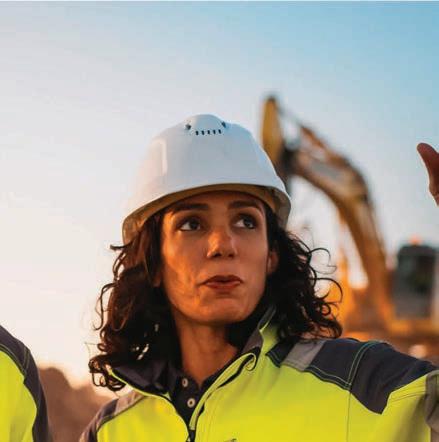

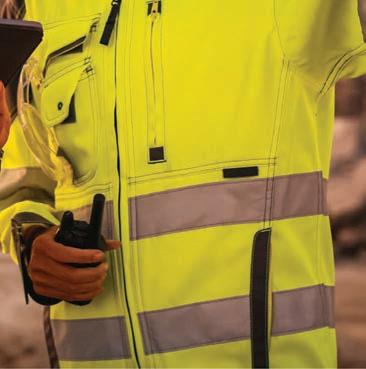









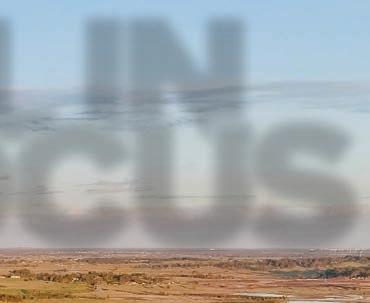

WHAT IS THE POPULATION SIZE AND LAND AREA OF YOUR COUNCIL?
Maitland City Council sits in the heart of the Hunter, spanning 396km² of verdant countryside, new and growing suburbs, and established town centres.
Maitland is one of the fastest growing local government areas in New South Wales, with a population of around 95,000 people now and an expected population of 145,000 people by 2041. That means we welcome around six new residents every day.
HOW MANY EMPLOYEES WORK AT YOUR COUNCIL?
Maitland City Council’s headcount is around 650.
WHO IS THE MAYOR?
The Mayor of Maitland is Cr Philip Penfold. Born and raised in Maitland, Mayor Penfold was first elected as a councillor in 2008 and has served as
mayor since 2021. His priorities include sound financial management, a focus on sporting and recreation infrastructure, and improvements to roads and traffic congestion.
WHO IS THE CEO?
Maitland City Council’s General Manager is Jeff Smith. Jeff boasts an impressive 30-year career in both the private and public sector and has previously worked in senior roles at Port Stephens, Randwick and Northern Beaches councils. Since joining Maitland City Council in July 2023, Jeff’s focus has been on shaping organisational initiatives, continuous improvement, asset revitalisation and renewal, and establishing a fresh corporate vision.
For the 2024-25 financial year, Maitland City Council is working with a $216 million operating budget. The budget
includes $156 million for service delivery and $60 million for a comprehensive infrastructure program.
For the 2024-25 financial year, $60 million of our overall operating budget is allocated toward a comprehensive infrastructure program.
A large percentage – 41 per cent – of the budget for that infrastructure program will be spent on improving, maintaining and expanding our road network, which currently spans more than 780km.
Parks, playgrounds, recreational facilities and sportsgrounds are a major focus too, as we cater to the needs of a rapidly growing population of young families moving to the region. In 2024/25, $13.1 million is allocated for recreation works, as well as $1.7 million for cycleways and footpaths to forge

connections between our suburban areas and improve our walkability.
Major projects for 2024-25 include:
•The replacement of Melville Ford Bridge ($8.2 million)
•Upgrades to the intersection of Raymond Terrace Road and Government Road, Thornton (now complete, $26 million)
•Stage two works at the Maitland Resource Recovery Facility ($3 million)
•Upgrades to Max McMahon Oval in Rutherford ($3 million)
•Gillieston Heights Skate Park and Playspace – (now complete, $927,000)
•Thornton Skate Park (now complete, $627,000)
Our vision for Maitland’s future is a connected city with thriving communities. Our new ten-year Community Strategic Plan, titled Maitland’s Future, reflects the aspirations and values of the Maitland community, with insights from over 2,000 residents and 3,700 contributions gathered.
The shared vision is underpinned by four key focus areas: liveability, sustainability, vibrancy and achieving together. These focus areas are integral to the future of Maitland and the next decade is set to be an exciting and rewarding time for all of us as Maitland embraces new opportunities and growth, becoming a dynamic place where people can live, work, enjoy and succeed.
Maitland is one of the oldest regional centres in Australia and sits on the banks of the Hunter River, centrally placed between the Hunter Valley’s vineyards, the hustle and bustle of Newcastle and its popular beaches.
It’s the heart of the Hunter, within touching distance of everything the region has to offer - the perfect blend of city convenience with a warm country charm.
Maitland is proud of its rich heritage. The historic township of Morpeth played an important role in the settlement of New South Wales in the 1820s, as one of the first and most important river ports to establish a trade route with the colonial outpost in Sydney.
Morpeth’s beautifully preserved buildings, uneven cobblestone paths and storied sites are rivalled only by
Maitland’s town centre, with its charming and historic High Street.
Sitting centrally on High Street is Maitland Town Hall, which was built in the late 1880s and played a key role in Australia’s federation. Our first Prime Minister Sir Edmund Barton opened his government’s campaign on its doorstep ahead of the first Federal Election in 1901.
Maitland is also well known for its vibrant and eclectic events calendar, with long-running festivals such as Hunter Valley Steamfest, Maitland Riverlights, Tocal Field Days and the Maitland Show playing a key role in attracting hundreds of thousands of visitors to our city every year.
Maitland is in the midst of rapid growth, with a changing demographic profile and an average of six new residents arriving every day.
Our local government area ranks among Australia’s top regions for millennial inflow, largely due to domestic migration from nearby areas such as Lake Macquarie and Newcastle.
As such, housing demand in Maitland continues to grow, however the coordination of state infrastructure to support our growing community continues to be an issue.
We’re geared to contribute approximately 25 per cent of the
region’s required dwellings over the next two decades.
Our healthy supply pipeline of residential land ensures Maitland is well equipped to meet these targets, with an average of more than 1,000 lots approved each year.
In the medium to long-term, the need to focus on vertical growth – building up rather than out – will provide a wider variety of housing stock for our growing population. Currently, the ratio of greenfield to infill development sits at 90:10.
In 2023, we adopted our Environmental Sustainability Strategy 2030 – a first-ofits-kind document that marked a major milestone in our journey towards a more liveable and sustainable Maitland.
The strategy outlines 13 targets across four theme areas, providing a roadmap for how we’re going to protect important natural spaces and deliver functional biodiversity corridors, increase active and sustainable transport opportunities, reduce greenhouse gas emissions, and better understand and plan for climate risks.
Since adopting the strategy, we’ve made big strides in reaching our sustainability goals.
As of 1 January 2025, our electricity supply is 100 per cent renewable.

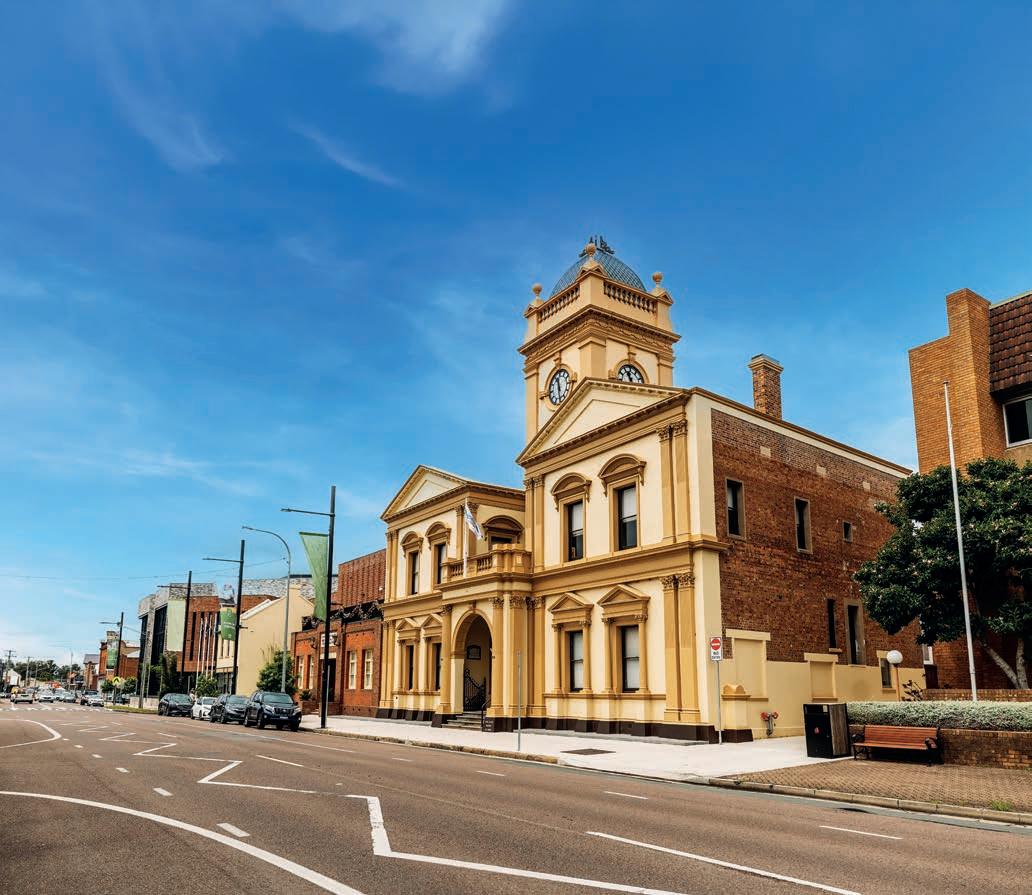
We signed a new partnership with green energy utility operator Iberdrola Australia in September last year, and this means that more than 10,000 public streetlights that are now over 85 per cent high efficiency LED, as well as all our major community facilities – like our libraries, pools, art gallery, town hall and office spaces – now run on energy sourced from renewable sources like solar and wind.
Not only does this put us ahead of schedule to halve our emissions by 2030, but it will also result in cost savings of around $564,000 or nine per cent compared to previous rates over the life of the six-year contract, allowing us to redirect that spend back into providing key services and infrastructure for our community.
Our community told us they’d like to see a greater push towards a circular economy where valuable resources are kept in production for longer and wastes are designed out of the system, preservation and protection of healthy green and blue natural spaces, more resilient and liveable communities, and a stronger focus on sustainable living practices.
Flooding has played a significant role in Maitland’s history, with this February marking 70 years since the 1955 Hunter Valley floods that, to this day, remain one of Australia’s worst natural disasters.
Climate change will only make the impacts of flooding more profound over time, so a significant focus of our
Environmental Sustainability Strategy is planning for climate risks and increasing community preparedness for natural hazards such as flooding.
Right now we’re in the midst of delivering a four-stage transformation at our waste facility. More than $18 million is budgeted for this work, which will result in infrastructure that provides our growing community with access to a modern waste management facility in Maitland for the long term.
Landfill airspace at our waste facility won’t last forever, so we’re committed to providing future-ready infrastructure. This project will increase our capability for recycling and resource recovery, with flexible spaces that can accommodate different automatic sorting equipment based on the availability of markets for resource streams.
And speaking of resource recovery, in June this year, we’re introducing a FOGO service to all households, to reduce the amount of household waste sent to landfill, as we build towards reaching an 80 per cent diversion rate by 2030.
Conversations: Art and Dementia is a free social and creative tour of current exhibitions that supports people living with dementia and their carers.
Held twice a month at Maitland Regional Art Gallery (MRAG), the
program aims to improve mental wellbeing, combat social isolation and help attendees develop ongoing quality relationships.
The program uses artworks and artmaking activities to trigger conversation and connection between people with dementia and their carers, encouraging attendees to share stories and express their thoughts and feelings.
Conversations: Art and Dementia is also delivered via outreach programming, enabling local care facilities to engage in the program at their own site or through organised transport to the Gallery.
MRAG recently received $50,000 in grant funding from the Primary Health Network to research the psychosocial benefits of Conversations: Art and Dementia in partnership with the University of Newcastle, as well as exploring ways of addressing barriers that may prevent people with dementia from participating in creative activities.
Over the past decade, Maitland Council has gone to great lengths to reinvigorate the city’s central business district and historic High Street, injecting vibrancy and colour into what’s now known as The Levee precinct.
Sitting centrally in The Levee is our award-winning Riverlink building, which

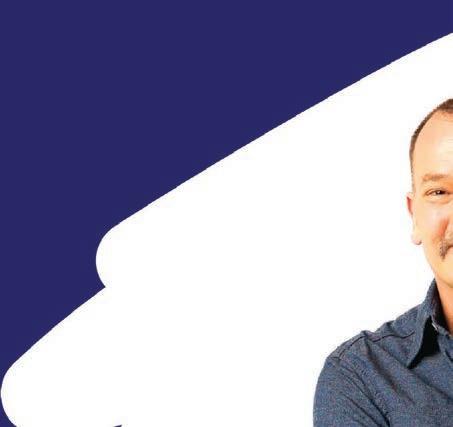

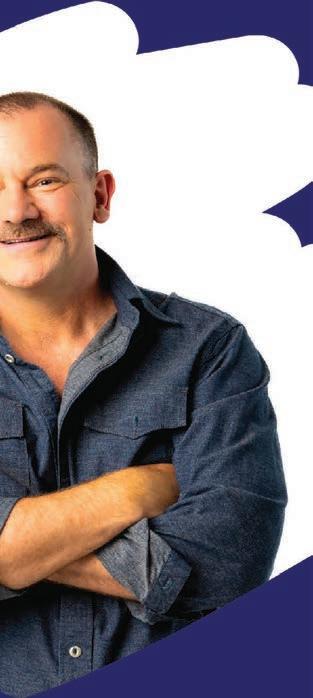
forges a connection between The Levee’s pedestrianised thoroughfare and a scenic walkway that winds its way along the banks of the Hunter River.
The Riverlink brings the two spaces together and serves as a dramatic backdrop for many of the events that Council holds in the centre of town, such as Maitland Riverlights festival and our annual New Year’s Eve fireworks display.
Not only that, but more than $35 million - $22.2 million of which was contributed by the NSW Government –has been spent on expanding the sports and recreational facilities in the centre of town.
Delivered over four stages, the Maitland Regional Sports Complex ties together a revitalised number one sportsground, brand new athletics centre and parkland, so that Maitland’s central business district can play host to major sporting events and cater for the needs of our growing community into the future.
With the finishing touches made just last year, the complex is already a popular destination for families and a drawcard for sports clubs, with our sportsground welcoming the Newcastle Jets for A-League and Australia Cup fixtures last year and Harold Gregson Park regularly playing host to live music, market stalls and food trucks.
The cherry on top of Maitland town centre’s transformation is the improvements made to Maitland Town Hall.
Improved facilities at Town Hall have brought the historic venue into the 21st
century, with changerooms, kitchen facilities and a stage loading dock making it an appealing multipurpose entertainment venue that can host business roadshow events one day and sellout standup comedy the next.
In 2018, we undertook an extensive review of our customer service functions and found that we needed to make some changes.
We found that outdated systems and legacy infrastructure limited our ability to keep pace with customer expectations, which had pivoted towards fast, digital-first self-service experiences. These systems also led to a fragmented service delivery, with multiple touchpoints and disconnected platforms leading to inefficiencies and poor visibility of incoming or open requests.
As a result, we embarked on what was termed our ‘customer-driven transformation’, a multi-year program of projects all centred around the desire to make all interactions with Council as seamless, effective and simple as possible for all our residents.
A key component of our customerdriven transformation was the development of a bespoke digital channel, where fragmented systems were consolidated into a single platform. Dubbed the MyCouncil portal, this solution has marked a major step
forward by streamlining customer interactions with Council services. What’s more, the portal was developed collaboratively with residents, through interviews, live testing and workshops spanning an 18-month period.
As a result, Maitland residents are now empowered to report issues, track the progress of their requests, and access a variety of services online, all within a user-friendly and secure platform.
We integrated a Salesforce CRM with other systems, like CFSuite and new Enghouse contact centre software, to unify and simplify the flow of information as community requests come in.
The implementation of MyCouncil has been transformative on customer experience and operational efficiency; our first-call resolution average has jumped from 43 per cent to 75 per cent, and average call time has decreased by 33 per cent.
Real-time dashboards in Salesforce have also unlocked data-driven decisionmaking, improving both resource allocation and strategic planning; better still, contemporary tools and streamlined processes have improved job satisfaction for our customer experience and frontline staff. We estimate that, as a direct result of the switch to Salesforce, that we’re saving $200,000 per annum.
The next, and current, phase of our customer-driven transformation sees us in the middle of an intense two-year implementation of a new enterprise resource planning solution, to further bolster and better our internal systems and processes.










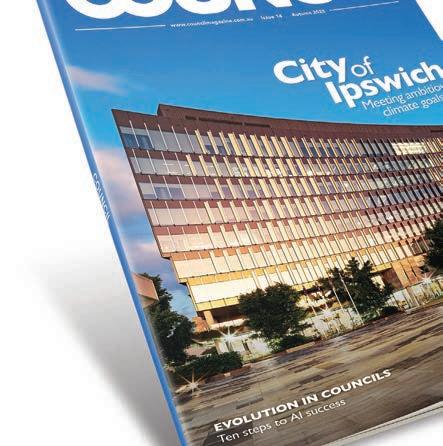

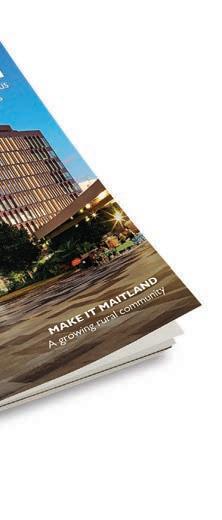
Combining the resources of our respected editorial team with the knowledge and insights of some of the best and brightest minds in the sector, Council keeps you informed of the critical news, updates and changes you need to be aware of.



With Geotab’s telematics technology, you can monitor almost every aspect of your vehicle fleet to gain the necessary insights to run operations smoothly and efficiently. Geotab’s devices can elevate your fleet management in numerous ways, including:

Vehicle monitoring to increase fleet visibility and cut down on costs.




Tracking and management to know exactly where your assets are.



Predictive maintenance and diagnostics to improve asset uptime.
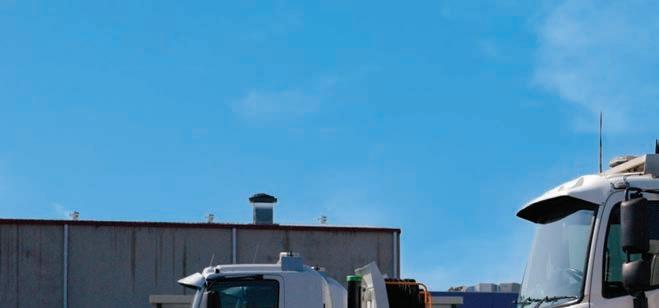

Installation is quick and easy on all kinds of vehicles. Get in touch to find out what solution will work best for your fleet at www.geotab.com/au/

On-vehicle cameras to help monitor garbage collection or driver safety.
